#like basically every sequence has one or two story-related events
Text
i fricking hate the notoriety system
#my posts#gameblogging#liveblogging ac#because it makes exploring a crime#like you're free to do almost anything as long as people don't see you#some actions don't even make it go up#but if i'm just running around looking for a tresure chest#with no one around for miles and not bothering anyone#and a guard on a horse gives me the stink eye because he doesn't like my face#my notoriety goes up and i gotta fucking look for a poster to rip off#just????? g e h#rome is 88% rebuilt tho so soon it won't be a problem#and also objectively speaking the guards are really well-designed#but jesus christ are they annoying#and the story-related segments are really short#like basically every sequence has one or two story-related events#and that's it#if it wasn't for everything else this game would be so extremely short#idk if it was the same in ac2 tho
0 notes
Text
Cipher Academy ch.58 thoughts
[Thank You For Playing]
(Contents: Reflection)
I think it's pretty clear from this chapter that Nisio had a lot of other storylines planned, though I'm not sure how much attention each one would have gotten
Toshusai's mission to round up the Gun Eyes, Yosaimura's mission to dredge up the Unsinkable Aircraft Carrier, and of course Iroha's mission to save the Battlefield Dancer, all could well have been their own story arcs, but it's also possible that all but the latter would have been background events. Regardless, Nisio is telegraphing that there was more story to tell, and that we'll need to fill in the blanks on our own at this point
In a certain sense, I appreciate that Nisio is showing me what could have been. Being given breadcrumbs even after the story's conclusion allows me to continue creating the story in my heart, even if the canon is beyond my reach now. To borrow Nisio's wording, it feels less like the story has ended and more like it's stopped
Endings usually come in one of two flavors - wrap-ups or "our journey continues," but this one kind of feels like both in a way. It's demonstrating how the previous storylines wrapped up, but while also showing what new journeys started since then and which were never completed. It's a bit more realistic in that way, as people's lives aren't stories that can be bound neatly in the narrative of a book
That said, this is still a story, and some elements do need to be presented neatly. With the story concluding with every class working as a unit, I think it's fair to say that my take that this was, at its core, a Friendship story was correct. I wonder if perhaps every first-year class was made to treat the other classes as enemies or rivals specifically to build up to the point where they would be allies later? It would make sense for a military academy to lean into basic team-building structure like that, as the stages go as follows: Forming, Storming, Norming, and Performing. Every class is built from strangers, they're put at odds with each other to become acquainted, their dynamics normalize, and then they can operate efficiently with that familiarity. It makes sense for this to be repeated at every level, from intra- to inter-class relationships, and possibly even inter-school relations. In the end, I do wish that we could have spent more time exploring those relationships, as they were easily the most engaging part of this narrative
Oddly, the most reassuring thing about this ending was that it kind of gave me closure to a question I've had for over a decade now: was Medaka Box canceled? Based on this ending, I'm inclined to say no. There are so many parallels between these two endings - the timeskip, the where-are-they-now, the final shot of a group photo, the literal credits sequence. It was all so familiar that I recognized it pretty much immediately, but there was one key difference: while Medaka Box took us through the goings-on of the entire casts' lives, very little of it felt like story that could have drawn out the series' lifespan. I mean, sure, it could have, but none of it felt like it was meant to be story that we would have seen directly. It was everyone catching up and talking about what they've heard their friends have been up to, but with the exception of Munakata becoming an exorcist when ghosts or demons haven't been an established concept up to this point, all of it was just "oh, she's a baker now, he's a cop now, he's a politician now, she's a calligrapher now," etc. None of it was of any real consequence to the lives of the cast, it was just flavor text to reminisce on the events of the story and how far everyone has come
Here, I feel like we could have seen all of it and it would have been engaging. We're not just touching base with old friends here, we're waking up from a coma and learning that we missed all of the fun. It's such a vastly different feeling that I can't help but feel like this is how it would have felt if Medaka Box were canceled, therefore it most likely wasn't
I'm sure I could come up with more to wax poetic on with this series, but to be honest, I'm getting exhausted here. It's heartbreaking seeing one of my favorites get cut down like this, and as some of you may have heard, Martial Master Asumi has been canceled as well. I don't want to harp on this for much longer and make myself sadder, so I'll conclude on as positive a note as I can
I had a great time writing about this series. Being able to explore shonen tropes through Nisio's lens is always a delight and a bit of a trip, and getting the chance to share that experience with others was great fun. Iwasaki's art was fantastic, as evidenced by how many of these girls I absolutely fell in love with, and I'm glad I got to see so many parallels to Akira Akatsuki's style. I actually have to wonder if the styles of both series were directed by Nisio's vision or if perhaps Iwasaki is a fan of Akatsuki. Either way, this last year has given me the opportunity to relive my time with Medaka Box while also giving me something completely new at the same time. I'm so grateful that Nisio and Iwasaki at least got to make it this far, and I hope that we'll get to see both of them again in the near future
To everyone who read all 58 of my reviews for this series, thank you so much. To everyone who only read a few here and there, or even only read this one, thank you as well. I'm glad I got to spend time with you and I hope my little essays enriched your experience, even a little
Until next time
9 notes
·
View notes
Note
hey frank! I was wondering if you have any tips on writing really good horror fiction and poetry. I'm a writer and these are my two main venues! Thanks :)
I don't know much about horror fiction, but I'll give you a handful of random pointers anyway:
Moral horror is more potent than gore. "Your parents have been murdered" is a pretty lame horror premise, but "you have killed your parents" is an amazingly potent one. (This principle is directly related to two of my previous recommendations: "write a story that shows how your character might get to that position," and "think about your character's concept of morality.")
Writing well is the most important part of making something scary. It's not always fun, and it's not particularly heroic, but it's one of the few skills that you can really control.
"You" and "yourself" are bad words for writing. When you're not feeling inspired, it's all too easy to just fall back on the words that are "foregrounded" because they are so familiar, and this can lead you to write in terms that are pre-packaged and familiar to every reader (but which you, as a writer, might not understand in the way that you understand, say, "purple hyacinth"). It's much more interesting if you describe what you see and feel, not in the words you are used to hearing, but in your own.
Stories are not "about" things; they are about actions. We can understand your story just fine if we fill in the vague notion of "whatever the hell that has to do with purple hyacinths" with a plausible action (or actions) by a plausible character acting in a plausible situation. We don't necessarily have to know, or care about, what purple hyacinths are.
I also don't know that much about poetry, but I'll still give a few pointers anyway:
Try to find a (metaphorical) "equivalent" of the visual imagery that you find most appealing in other, non-verbal art. There are multiple ways of doing this -- the Alice Notebooks is a good inspiration here
As for horror, moral horror is really really powerful in poetry as well
This is all assuming that you have already mastered basic craftsmanship. You know how to put words together, and you understand how to make your character's words, actions, and motivations seem real. Don't worry too much about the big picture if you have little or no experience with the actual writing part of writing; spend more time on this until you feel comfortable on that.
Finally, while there are different aspects of horror fiction, the story form is inextricably linked to the story content. That is, a story with the same subject matter will not necessarily be horrific in the same way, or horrific at all (if it's going for a different kind of effect, like "suspense," for instance). The content will govern the form, not vice versa. So, if you're writing a story about a character who experiences horror, it's probably a good idea to find a way to write it from their perspective instead of writing it from the perspective of some sort of third-party "observer." If it's from the character's perspective, you can feel their emotions and ask yourself why they feel these emotions -- rather than asking yourself why a third party would feel those emotions.
This doesn't always work -- if you're doing something more like a "horror monologue" or a "horror sequence of events" that's not about any one character in particular, that might be good -- but it's probably the best way to start. (What I call "suspense" is likely to do well in a third-party, "observer" style.)
7 notes
·
View notes
Text
Daniel LaRusso: A Queer Feminine Fairytale Analysis Part 1 of 3
Disclaimers and trigger warnings:
1. These fairytales are European, although there’s often overlap in themes globally. I know European fairytales better, which is essentially the reason I’m not going to branch out too far. I opted to also stick to Western movies so as not to narrow things down, but also in particular “waves hand towards all of Ghibli” amongst many others. There’s a reason the guys in Ghibli are so gender.
2. TW for discussions of rape culture and rape fantasies
EDIT: FUCK I’M A GOBLIN CHILD! FORGOT TO PUT A MASSIVE MASSIVE THANK YOU TO @mimsyaf WHO HAS BEEN THE NICEST, KINDEST EDITOR ON THESE THOUGHTS AND CONTRIBUTED SO MUCH TO THEM AND GENERALLY IS A WONDERFUL PERSON!
Part 2
Part 3
1. Introduction
I recently wrote a little thing, which was about Daniel as a fairytale protagonist – specifically one that goes through some of the kinds of transformations that are often associated with female protagonists of fairytales.
I used quotes from Red Riding Hood, Labyrinth, Buffy The Vampire Slayer, and Dracula, which, as an aside – the overlap between fairytales, horror, and fantasy and the ways each of those genres delve into very deep, basic questions of humanity and the world is something that will always make me feral. I will be generally sticking with fairytales though. Also I am very excited about some of those Labyrinth concepts going around!
I’m going to use “feminine” and “masculine” in both gendered (as in relating specifically to people) and non-gendered (as in relating to codes) ways throughout this, depending on context.
To be binary for a moment, because sample-sizes of other genders are low, women are usually able to fall into either feminine or masculine arcs, although sometimes the masculine-coded woman can become a “not like the other girls” stereotype and the feminine-coded woman a shallow cliché – in both cases they’re also under more scrutiny and judgement, so it’s always worth asking “is this character not working for me because of the writing or because I have ingrained biases? (Both?)”
Men don’t often get feminine-coded arcs. Because. Probably a mix of biases and bigotry. But there are some that seem to have slipped beneath the shuttered fence of “Sufficient Narrative Testosterone,” and Daniel LaRusso is one of them.
2. Some Dude Comparisons (Men Doing Manly Action-Hero Things like being trans symbolism and loving your girlfriend… seriously those things are hella manly, I wish we saw more of that onscreen…)
a. Neo
Much like Neo The Matrix, whose journey is filled with transgender subtext and specifically and repeatedly references Alice In Wonderland, Daniel doesn’t go through quite the kind of hero's journey usually associated with Yer Standard Male Hero, especially the type found in the 80s/90s.
Neo is my favourite comparison, because of the purposefulness of his journey as a trans narrative and the use of Alice. But I’m sure there are other non-traditional male heroes out there (but are they trans tho? Please tell me, I want trans action heroes).
Neo “passes” as a socially acceptable man, but online goes by a different name - the name he prefers to be known by - feels like there’s something inherently wrong about the world around him and his body’s place in that society, and then gets taken down the rabbit hole (with his consent, although without really “knowing” what he’s consenting to) to discover that it’s the world that’s wrong - not him. And by accessing this truth he can literally make his body do and become whatever he wants it to.
Yay. (The message of the Matrix is actually that trans people can fly).
Neo is – kind of like Daniel – a strange character for Very Cis Straight Guys to imprint on. He spends most of the first movie unsure about what’s going on, out of his depth, and often getting beaten up. He is compared to Alice several times and at the end he dies. He loses. He has to be woken up with true love’s kiss, in a fun little Sleeping Beauty/Snow White twist. Yes, after that he can fly, but before that he’s getting dead-named and hate-crimed by The Most Obvious Stand-In For Normativity, Agent Smith, and being carried by people far more physically capable than he is (people who also fall outside of normative existence).
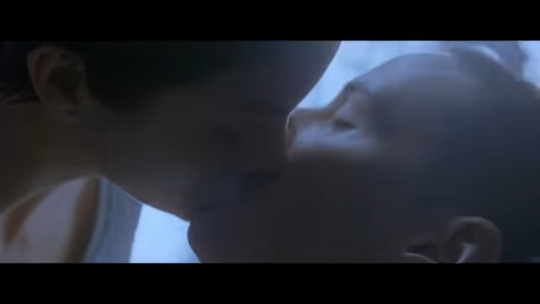
Trinity and Neo in The Matrix. The fact that a lot of the time neither of them is gendered is something. Literally brought to life by true love’s kiss.
I’m not about to argue that Daniel LaRusso is purposefully written along these same thought processes, so much as the luck of the way he was written, cast, directed, acted, and costumed all came together in the right way. And this is even more obvious when compared to That Other Underdog Fite Movie That Was By The Same Director as Karate Kid.
b. Rocky
The interesting thing about Rocky is that he is (despite being a male action icon) also not written as a Traditionally Masculine person. Large portions of Rocky – and subsequent Rocky films – are his fear and insecurity about fighting vs his inability to apply his skills to another piece of work and wanting to do right by his girlfriend (and future wife), Adrian. The fighting is most often pushed onto him against his will.
Much like in Karate Kid there is barely any fighting in Rocky I. Most of it is dedicated to how much Rocky loves Adrian and the two of them getting together. The fight is – again like in Karate Kid – a necessary violence, rather than a glorified one (within the plot, obviously watching any movie like this is also partly about the badassness of some element of the violence – whether stamina or the crane kick, it’s all about not backing down against a more powerful opponent).
Rocky is played by Sylvester Stallone. He’s tough, he’s already a fighter (albeit in the movie not a great one yet), he’s taking the fight for cash – so although he’s also soft-spoken and sweet, you’re aware of the fact that he’s got those traits that’d make a male audience go “Hell Yeah, A Man,” or whatever it is a male audience does watching movies like that… cis straight men imprinting on oiled muscle men sure is a strange phenomenon, why do you wanna watch a boxing match? So you can watch toned guys groaning and grappling with each other? Because you want to feel like A Man by allowing yourself to touch the skin of other men?

Apollo and Rocky in Rocky III. This sequence also includes prolonged shots of their crotches as they run. Sylvester Stallone directed this. This was intentional. Bros.
Daniel LaRusso is not built like that. But that doesn’t really have to matter. Being smallish and probably more likely to be described as “pretty” than handsome, and not having a toxic masculine bone in his body does not a feminine archetype make. It just makes a compelling (and pretty) underdog.
c. Daniel
So where does the main difference really lie? Between Rocky and Daniel? Well, Rocky has the plot in his hands – Daniel, largely, does not. Rocky is acting. Daniel is reacting or being pushed into situations by others. Just like our boy Neo. Just like Alice in Wonderland, Cinderella, Snow White – just like some of the women in some contemporary(ish) fairytale films like Buttercup (Princess Bride), Dorothy (Wizard of Oz), or Sarah (Labyrinth).
This isn’t a necessary negative about stories about girls and women, so much as looking at what it is girls and women in fairytales have/don’t have, what they want, and how they’re going to get it. It’s about power (lack of), sexuality (repressed, then liberated), men, and crossing some taboo lines. It’s also about queerness.
3. The Karate Kid Part One: Leaving Home
Daniel LaRusso is a poor, skinny, shortish kid (played by a skinny, shortish twenty-two-year old) who doesn’t fit in after having been taken away from the home he was familiar with against his will. Not every male protagonist in a fairytale leaves of his own will, and not every female protagonist leaves under duress – Red Riding Hood, for example, seems perfectly happy to enter the forest. However generally a hero is “striking out to make his fortune,” and generally a heroine is fleeing or making a bargain or being married off or waiting for help to arrive. She is often stuck (and even Red Riding Hood requires saving at some point).
Daniel then encounters a beautiful, lovely girl on the beach, puts on a red hoodie (red is significant), is beaten up by a large, attractive bully, loses what little clout he may have had with his new friends, and generally has a mostly miserable time until he befriends and is saved by Mr Miyagi. To do a little Cinderella comparison: Miyagi is the fairy godmother who pushes Daniel to go to the ball in disguise as well, and that disguise falls to pieces as he’s running away.
Then Daniel asks for help, Miyagi gets him enrolled in a Karate Tournament, and starts teaching him. Daniel wins the tournament and gets the girl, the end.
While Daniel has chutzpah and is a wonderful character, none of the big events are initiated by him, except for the initial going to the forest/beach (and within all of these events Daniel absolutely makes choices – I’m not saying he’s passive): Lucille takes them to California, Miyagi pushes him to go to the dance, Miyagi again decides to enroll him in the tournament and trains him, and only because Kreese doesn’t allow for any other option, Ali is the one who more often than not approaches Daniel, and even their first encounter is pushed by Daniel’s friends.

Daniel really is at a dance/ball in disguise and receives a flower from a girl who recognises him through said disguise, it’s unbearable! It’s adorable! I get it Ali, I fucking get it!
Daniel’s main journey within this – apart from not getting killed by karate thugs (love u Johnny <3) and kissing Ali – is to learn from Miyagi. He’s not necessarily a full-on feminine fairytale archetype at this point, although there are fun things to pull out of it, mainly in the context of later films and Cobra Kai: the subtext of karate and how that builds throughout all the stories, the red clothes, the themes of obsession, his being targeted by boys whose masculinity is more than a little bit toxic and based on shame… more on all that coming up.
He doesn’t technically get a home until they build him a room at Miyagi’s place, but he definitely leaves the woods at the end of this one, trophy lifted in the air after being handed to him by a tearful Johnny and all.
And then they made a sequel.
4. The Karate Kid Part Two: Not Out Of The Woods Yet
Daniel’s won the competition, Kreese chokes out Johnny for daring to lose and cry, more life-lessons are given (for man without forgiveness in heart…) and Daniel and Ali break-up off-screen, confirming that TKK1 was not really about the girl after all, which, despite Daniel and Kumiko having wonderful chemistry, is also an ongoing theme. Daniel enters the screen in The Most Baby-Blue Outfit seen since Tiana’s dress in Princess and the Frog? Or that dress in Enchanted? Maybe Cinderella’s (technically silver, but later depicted as blue)?
(Sidenote: At everyone who says Sam ought to wear a callback to that suit, you are correct and sexy).
Surprise, Miyagi’s building him a room.
Double-surprise, Miyagi needs to go to Okinawa.
Triple surprise, Daniel reveals he’s going with him, because he’s his son dammit.
The Karate Kid Part Two is maybe the least Daniel-LaRusso-Feminine-Fairytale-Protagonist of the three, because it’s not really his movie. Daniel runs around with Kumiko (aka the most beautiful girl I’ve ever seen), continues to be The Best Non-Toxic Boy a middle-aged Okinawan karate master could ask for, lands himself another Built Karate Rival (twice is just a coincidence, right? Right?), and eventually doesn’t die while wearing red again – twice: When Chozen almost strangles him to death at the Miyagi dojo and then during the final fight. The Saving Of The Girl (both the little girl in the storm and Kumiko) actually puts him in a more traditional masculine space than the previous movie did, even if the main theme of the film is about compassion and kindness and by the end, once more the boy whose masculinity is built on rockhard abs and matchsticks is on his knees. Daniel just has that power over big boys. It’s called kick/punch them in the face hard enough that they see stars.
There’s an aside to be made here about how much Daniel really is an observer in other peoples stories in this, although he is the factor that sends both Chozen and Kumiko into completely different directions in life (Chozen and Kumiko main characters when?) Anyway he comes out of it presumably okay, despite being almost killed. Maybe a few therapy sessions and he’ll get over it. Too bad Terry Silver is lurking around the corner…
5. The Karate Kid Part Three: The Big Bad Wolf
Alright people have written Words about the third movie. It’s fascinating. It’s odd. It’s eye-straining. It’s like olives – you’re either fully onboard the madness or it’s too off-putting for you (or you’re like. Eh, don’t see what all the fuss is about either way...). It’s basically a non-consensual secret BDSM relationship between a guy in his thirties (played by a Very Tall twenty-seven year old Thomas Ian Griffith) and a 17/18 year old (played by a shorter twenty-eight year old Ralph Macchio).
Also recently we got more information on Mr. Griffith’s input on the uh… vibes of the film. Apparently it wasn’t just The Sweetness of Ralph Macchio’s face, the screenplay (whatever that amounted to in the first place – release the script!), the soundtrack, the direction to not tone it down under any circumstances, the fact that Macchio categorically refused to play a romance between himself and an actress who was sixteen, no: it was also TIG coming up with fun ways to torture Daniel’s character and suggesting these to the director. Clearly everyone has fun hurting Mr Macchio (including Mr Macchio).
The point is that aaallll of that amounts to that Intense Homoerotic Dubiously-Consented-To D/s subtext that haunts the movie and gives a lot of fun stuff to play with. It’s also a film that – if we’re analysing Daniel along feminine-coded fairytale lines recontextualises his role in this universe.
The Fairytale goes topsy-turvy. Through the looking glass. Enter Big Bad Wolf stage right. Karate is a metaphor for Daniel’s bisexual awakening.
“Oh, when will an attractive man touch me in ways that aren’t about hurting me?” he asks after two movies of being hurt by boys with rippling muscles. “Why do men continue to notice me only to hit me? Do you think wearing red is making me too noticeable? Anyway, Mr Silver looked really good in his gi today.”
Daniel’s diary must be a trip.
#daniel larusso#the karate kid#cobra kai#ck#johnny lawrence#cobra kai meta#my writing#part one of three#some comparisons to matrix and rocky because I love to talk about those#terry silver
85 notes
·
View notes
Text
TMBS Book 1 Brain Dump
~An Embarrassingly Long Post~
I don’t know why I’m writing this or why I’m so determined to do it. Maybe to finally assume my true form and become a mega dork on main, or maybe just for fun!
This is basically a compilation of all the main points running through my head after reading The Mysterious Benedict Society (2007) for the first time. Rather than posting a ton and spamming the tag, everything’s here in one neat package! (hopefully this gets it all out of my system rip)
Contents:
The Book Itself
The Book Itself, for real this time
The Characters
A Funny Parallel
The S.Q. Section
Lines & Scenes I Liked
Spoilers abound!
The Book Itself
Upon acquiring the first three books (don’t judge me pls), I was surprised at just how long they are. Like, they’re still pretty light being paperbacks and all, but these books are hefty lads.
The first book has this Disney+ Original Series circle thing printed on it, which is kind of unfortunate. Regardless, I love the cover illustration and yellow is actually my favorite color :D It made me weirdly quite happy whenever I saw the book lying around in my room
Also, it’s really cute how there’s a letter from Mr. Benedict at the end! (It only reveals that you can find out his first name if you “know the code”, meaning the bit of Morse printed below the summary on the back.) Shock and horror, though, as I realized I’m starting to recognize some of the letters

The Book Itself, for real this time
It’s wonderful how the tone of the book really shone through to the show adaptation. Something about the deliberateness of the aesthetic, from the set designs to the fashion to scene compositions, that really sells that particular style— like it’s very clear that this story is being told to us, rather than one we’re seeing unfold, if that makes sense.
Where that narration style stood out to me the most was the first chapter. We are told (rather than shown) how Reynie gets himself to the point of the second test, and there’s this whole twisty time maneuver for that whole sequence of events that’s really interesting
A super secret fun fact about me is that I wanted to be a writer when I was younger! So this particular balance of show vs. tell is really neat, since it runs counter to my own tendencies. The sheer amount of commas in every sentence is also kind of comforting, since Ahah, I Do That in those few serious-ish attempts at writing lol
Overall this book’s style reminds me a lot of Roald Dahl’s books, which are very nostalgic for me :D The whole “kids are more competent than adults” angle helps a lot too haha
The Characters
Oh boy here’s where I get a little bit critical! Overall I did really like this book!! it’s just that that expresses itself in all this weird “”analysis”” lol
Reynie - much better in the books than in the show
It’s sort of a lukewarm take but I feel like show!Reynie is kind of boring? He doesn’t have a lot going on flaw-wise, and obviously since he’s the protagonist he can’t have too many weird traits or else the kids watching can’t project themselves onto him as easily
(I call it the difference between an aspirational protagonist and a vessel protagonist. Going off of the Roald Dahl vibes, think Matilda vs Charlie. show!Reynie is more of a Charlie)
Thus when we get to see him really struggle with the Whisperer and doubt himself it gives him a lot more dimension, at least in my opinion
It is a federal crime that the white knight scenes were not adapted into the show
Sticky - my son
I’ve long held to no one besides myself and my long suffering sister that Sticky is The Best Member of the Society
He happened to hit a lot of the Bingo squares of Stuff I Like In Characters: glasses, anxious, nice :), kind of a coward but ultimately is there for his friends, etc
For some reason I don’t talk about him nearly as much as you-know-who, but I love him just as dearly
Kate & Constance - I don’t have much to say
Kate is really interesting in this book! I like how we get to see more of her depths, in particular that one passage about her belief that she is invincible being the only thing that keeps her from falling apart? :c
Also her constant fidgeting is relatable lol
Constance is somehow a lot more tolerable in the book. I think I’m just one of those people with no patience for small children, unfortunately lol
(Some of) The Adults
It’s interesting that they had such an offscreen presence for most of the book. Giving them more time was probably one of the stronger changes of the show
However if that decision was made at the expense of the white knight scenes I think the choice should have been clear
I like the way Rhonda and Number Two are written
Milligan always on sad boy hours 😔✊
The “mill again” passage is touching but kind of messes up the pacing of the getaway, at least for me. Maybe I should read it again to make sure I didn’t miss something
Miss Perumal is much better in the show. We see so little of her in the book she doesn’t function well as an emotional anchor for Reynie, imo
The Institute Gang
Jackson and Jillson serve their purpose well, and Martina was surprising to say the least. I like the direction they took her in the show! I can’t imagine how funny it must have been to watch the tetherball subplot come out of nowhere lolol
These sections were written out of sequence, so random tidbit I couldn’t fit in The S.Q. Section: I like how he stumbles over his words. relatable
Mr. Curtain
While I think I know why they decided to not give Curtain the wheelchair in the show, we were totally robbed of Actor Tony Hale’s performance for the reveal during the final confrontation
Speaking of the wheelchair, it’s such a powerful symbol of his need for control or rather, his fear of losing it
The Contrast between him and Mr. Benedict. This point is expanded on in A Funny Parallel
Mr. Benedict
Oh boy, Mr. Benedict… How do I say this
I find it hard to trust Mr. Benedict, unfortunately
I mean to say, I do in the sense that I know he would never hurt the kids, thanks to knowing that a) this is a children’s book series and b) the meta (tumblr) states that he is really nice and lovable and stuff, but seriously. Why do the kids trust him at first?? I probably missed something somewhere
I like to think I’m an optimistic person, but unfortunately I’m also super paranoid. The premise of “a bunch of vulnerable orphans team up with a strange old man” is just so odd to me I don’t know how to explain it
I don’t know!!! I really want to trust Mr. Benedict
One of the strengths of the show is that we get to see him more often, and thus he gets to acknowledge more often that the plan is weird and that he feels really badly for putting the kids in danger and that he’s trustworthy and genuine
But his lack of presence for most of the book just makes him into something of a specter, invisible and unknowable, speaking only in riddles from across the bay
Which is why the white knight scene is so important!! I loved that scene ;-;
Because here’s an actual emotional connection! We can actually see it happening, rather than only being told that it exists
Reynie asking for advice and receiving encouragement, in words that demonstrate that Mr. Benedict actually cares about him and worries about him and agghh
It is a federal crime that the white knight scenes were not adapted into the show
But overall this whole issue didn’t ruin my enjoyment of the book at all! It’s just ->
A Funny Parallel
Okay, ready for my biggest brain, hottest take ever??
Mr. Benedict and Mr. Curtain…. are… the same
I mean obviously not entirely, given that one is benevolent and kind and the other is… Mr. Curtain
But seriously. Genius old man seeks out children (mainly orphans) to enact a plan. Said children often end up incredibly devoted to his cause and deeply admire him this is a little flimsy
Undoubtedly that’s intentional and is supposed to show the difference between them, like some kind of cautionary tale? “Let yourself be vulnerable and let others help you, lest you turn eeeeviiillll”
I guess that’s where the aforementioned epic contrast comes in. You get Mr. Curtain, strapped into his wheelchair and hiding behind those mirrored sunglasses, terrified (but unwilling to admit it) of ever showing the tiniest hint of vulnerability, vs. Mr. Benedict, who can let himself fall knowing that someone will catch him :’)
Anyhow I have nothing against the parallels, I just think it’s funny
The S.Q. Section
The S.Q. Quarantine Thread so it doesn’t leak out everywhere else <3
I’d like to meet the emo angstlord genius who read this book and decided to make SQ into Dr. Curtain’s son. What in the world
Okay I should probably preface this by saying that I absolutely adore both book!S.Q. and show!SQ with all my heart. Somehow, despite being a completely different character in both mediums, he has managed to be one of the best characters in either and certainly one of my favorites (besides Sticky of course) in the entire franchise, despite the fact that I’ve only read the first book/watched the show so far. I am confident in this statement.
But seriously! How?? Why?? I could probably write a whole other essay about why show!SQ is such an interesting character, and the change works so incredibly well. I’m just. Baffled
Okay, focus. book!S.Q. is such a sweetheart, oh my goodness. Like, 100% one of the most endearing characters in the book. Poor guy. I don’t even know where to start!!
He just seems to be a genuinely good guy at heart, despite being technically one of the bad guys. He’s genuinely happy for Reynie and Sticky when they became Messengers and helped Kate when she “fell” and was concerned about Constance when she looked sick and how he was in that meeting with Mr. Curtain and Martina?!!? aaahhhhghgh ;-; he just wants people to be happy TT-TT
Comparing him against literally every character at the Institute is probably what makes him so endearing tbh. When everyone else is so awful to the kids, it really makes him stand out. Like a cheerful little nightlight in the worst, most humid and rank bathroom you’ve ever been in
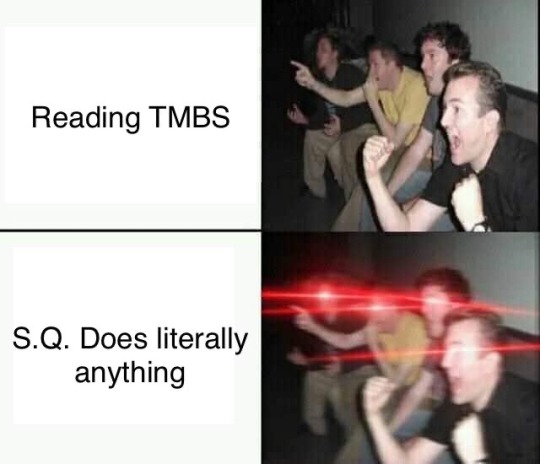
It’s kind of pointless to theorize about a book series that’s already concluded (I think?) but. Is the implication of S.Q.’s forgetfulness supposed to be that Mr. Curtain used him in brainsweeping experiments somehow? The timeline probably definitely absolutely doesn’t line up but like. How did he get to being a Messenger being the way he is now, given how cutthroat the process is? And then of course Mr. Curtain keeps him around as an Executive because he’s fun to mess with and presumably his loyalty. I’m very curious as to how their relationship develops in the other books, if at all. Those are probably where the seeds of the “let’s make them family” logic were planted
But wouldn’t it be hilarious if the reason we don’t know what “S.Q.” stands for in the books is that he just. Forgot
Another thing that occurred to me. Given that he and the other Executives were Messengers at some point, what were their worst fears? What is S.Q.’s worst fear?? Inquiring minds need to know
One last horrible little anecdote: I was thinking about book!S.Q. while eating breakfast, as one does, and suddenly it hit me.
I want to believe The Author Trenton Lee Stewart had the name for a character, S.Q. Pedalian, and was like, “Hm! What sort of quirky trait should this young fellow have?” Because, of course, in this style of fiction every character has to have at least one cartoonish or otherwise distinguishing trait to stand out in the minds of children. (For instance, Kate has her bucket, Sticky has his glasses, Constance is angry, and Reynie is Emmett from the Lego Movie)
Anyhow, he looks around the room, searching for inspiration. Suddenly he comes across a jumbo box of plastic wrap. Completely innocuous in design, save for one line of text. 300 SQ FT.
“…large… S.Q. …feet? THAT’S IT!” i’m sorry
Lines & Scenes I Liked
In no particular order!
Sticky quotes Sun Tzu, The Art of War
Evil combination aerobics/square dancing in the gym with the Executives
Everyone being happy at the end :’)
Everyone partying after Sticky reunites with his parents, and later finding Mr. Benedict asleep at his desk from the moment they shook hands :’’)
Literally any scene with Sticky in it
Any time Kate says “you boys” or “gosh”
[“Um, sir?” S.Q. said timidly, raising his hand. “A thought just occurred to me.” / Mr. Curtain raised his eyebrows. “That’s remarkable, S.Q. What is it?”] clown prince of my heart </3
S.Q.’s determined monologue about searching for clues after he bungled up the first time
Literally any scene with S.Q. in it (please refer to The S.Q. Section)
Reynie trying to resist the Whisperer.
[Let us begin. / First let me polish my spectacles, Reynie thought. / Let us begin. / Not without my bucket, Reynie insisted. He heard Mr. Curtain muttering behind him. / Let us begin, let us begin, let us begin. / Rules and schools are tools for fools, Reynie thought.]
NO MORE HURTIN’ WITH CURTAIN
Milligan showing up on the island!!
Remember the white knight hhhhhh
“controle”
A Super Secret Bonus Section
I would be extremely surprised if anyone read through all the way down here lol. Regardless, here’s a little acknowledgements section :D not tagging anyone since I don’t want to bother all of these people
Special shoutout to tumblr blog stonetowns for unknowingly yet singlehandedly demolishing my reluctance to read the books by posting a ton of cute quotes. Thank you for your service o7
Thanks to the two OGs that liked the post I made right before this one, for being my unwitting enablers and for sticking around despite being a) technically an internet stranger (hello!) and b) someone I haven’t spoken to irl in literal years (hey!!)
Last but not least thankz 2 my sister for putting up with me ranting about the book when I first got it and for asking about “CQ” sometimes lol. (i desperately hope you’re not reading this orz)
#the mysterious benedict society#this took me like three days to finish rip#it’s worked though! i feel less of a Mighty Need to think about this stuff constantly now#however!!! today through some conniving i have gotten the Second Book#now I’m at 3 out of 4 infinity stones. muahahaha#was going to include my villain origin story about why i like show!SQ so much but cut it for being too long and irrelevant. however#if the words jeff naomi and Sweet Dreams are Made of These mean anything to you please hit me up. it’s kind of a funny story
31 notes
·
View notes
Note
hi if it’s not too much trouble do you mind elaborating on the post about the cinematography being better in s7? bc i 100% agree and have been thinking the same but also haven’t really been able to articulate why? like if someone asked me this anon i wouldn’t be able to give them specifics but i KNOW it’s different. sorry 😅
it's definitely not too much trouble i already know this is gonna be long as shit bc i have so many Thoughts on the matter
it is indeed p hard to articulate so i'll give some examples & comparisons n share my thoughts based on that!
first i think it's important to recognize the context of a show like skam. it is made to represent every-day teenagers who might enjoy but not ever relate to characters & stories on some fantasy/murder mystery shows abt teenagers. the very core of skams is realism n accuracy to real life. we as the audience are not only supposed to be onlookers of the events we're meant to feel connected to the stories n relate to the main characters.
skamfr has some VERY beautiful shots if u look at them independently. if someone just showed me a screenshot of one of them i'd be like wow! that's stunning! but that's not what i'm supposed to feel when it comes to skams. if i go watch an artistic full length movie at the theaters i Do want to see beautiful shots that look like art n have a lot of symbolism behind them but when i watch skam i'm supposed to think "that could be me. that looks like my life" i'm not a lowly spectator who could never have such a beautiful life but instead the audience should see their lives directly put on screen.
skam france has been rly consistent w it tho! it's been their brand since like season 3.. but it did get worse in s5 & 6 i think bc they started to try too hard for original storylines. i think it's very intentional n if they were making another show i wouldn't say it's bad rly (altho sometimes it is that too bc they try too hard fmgjkd). out of context a lot of their cinematography works bc they usually tie it into the plot to represent the events but they just picked the wrong style for a web series. like babes u are not submitting this to the academy pls chill.
now let me introduce u to the most despicable shot in skam history (in my humble opinion)
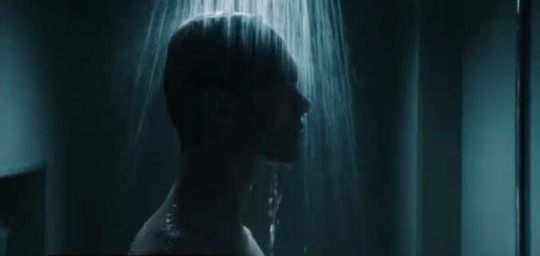
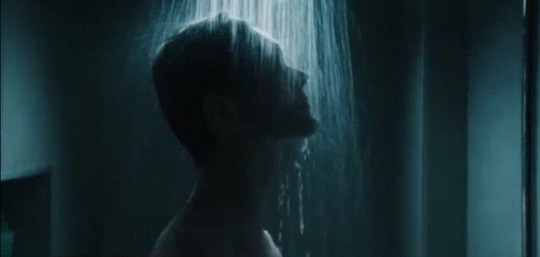
HELLO??
now before anyone says. yes i know this sequence of shots has a purpose. this is exactly what i mean that if it was some other show w different goals it wouldn't be such an issue bc yeah this looks great right? it's a "sensory clip" we r supposed to "hear" what it's like to be deaf n specifically what it's like for arthur. but.
let's put this into skam context. we as the audience should see ourselves in arthur, not necessarily entirely but we should feel he's just like us, a teenager w his own unique struggles & life experiences. now tell me, when u feel depressed or sad or have had the worst week of ur life n u must drag urself to the shower... is this what it feels like? first of all do u take the shower in the fucking dark???? just for the aesthetic?? do u stand DIRECTLY in the middle letting the water hit u exactly on the top of ur head forming a symmetrical shade on u while u just... stand there. do u feel like ur ascending in the shower as u dramatically raise ur chin literally what the actual fuck is this. don't get me wrong sometimes u just actually do stand there doing nothing bc u just feel so horrible but that's not rly the feeling this clip awakens?
this leans a bit into the romanticization of arthur's season which wouldn't be as bad (still cringy but not as bad) if arthur had already accepted himself at this point but no he's basically suffering in the shower n we are looking at him like wow that's so pretty. let's imagine how we could make this clip feel more real n how we could actually see ourselves in him here:
stop making ur main characters of the season the main characters of the world. just bc arthur is feeling terrible doesn't mean the whole world imitates his feelings. in a symbolic movies masterpiece it would but not in a concept like skam. one of the worst things abt feeling terrible is seeing how the world just goes on around u. imagine how real it would feel like if he was in the shower w the generic yellowish light on that a lot of bathrooms have. we could see his silhouette slouching in the shower through a shower screen. or maybe a shot similar to the example pics but the ugly lights are on n the water is annoyingly dripping in his eyes & he doesn't look like they're trying to give him a halo n make him into a jesus archetype. the bathroom would look the same it looks on a rly happy day or a boring day bc this day only sucks for arthur n the universe isn't gonna come to his house to give him a cool background bc of it
same w this comparison


two underwater shots, both rly pretty & heavy on symbolism but the other one is literally waiting for those "this looks like a renaissance painting" comments n the other is rly pretty but still looks like real life humans who r not doing a photo shoot for vogue. which do u find more relatable? which situation makes u think Yeah that's real life?
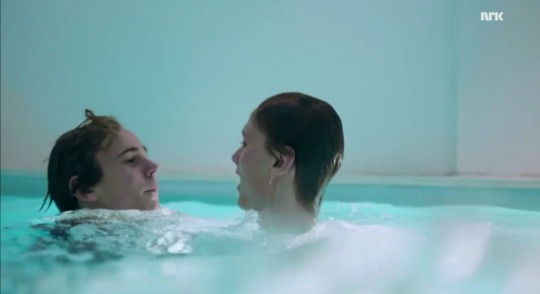
like look at this camera position of "barely above water" this is like.. almost "ugly" but it's so fucking real n probably closest to the feeling of a first person point of view shot that u can get to
now the s7 camera decisions seem sooooo much better compared to all this. they have a lot of time to still make super dramatic shots that distance the viewer from the story line but so far so good. maybe they'll pick this up again to make the world revolve around tiff as she faces hardships but let's hope not 🙃
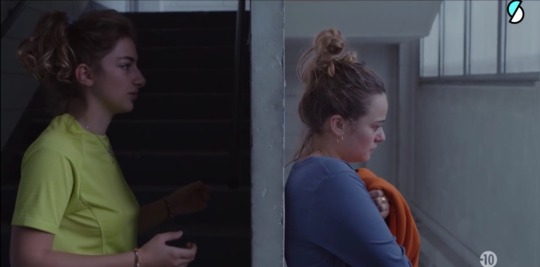
i genuinely love this shot like it's super down to earth & feels real but they have still easily kept in the symbolism. like tiff is literally putting walls between others n herself. jo feels like she's literally talking to a wall. tiff feels alone & secluded even tho someone is in the same room as her. yet they didn't have to make it look like smth out of an obscure indie film whose purpose is to have the audience in awe instead of representing them.
yeah the first person point of view of jo going in and out of frame while doing sit ups mightve been weird or cringy but 1. that's skam for y'all & 2. i'll choose that any day over arthur ascending like jesus in the shower.
56 notes
·
View notes
Text
Film-making, like almost every other creative endeavour, requires not just an incredible level of talent and hard work but also immense fortitude. Naturally, good films are hard to come by. Masterpieces, however, are rare. A movie is most often just a source of entertainment for viewers; at times, it is a medium of abstract communication with actors they admire. However, cinema truly becomes art only when it is able to stimulate the emotions as well as the artistic sensibilities of its audience. And Jodha Akbar does exactly that. It is without an iota of doubt, a masterpiece of the modern era that ought to be watched by art lovers across the world.
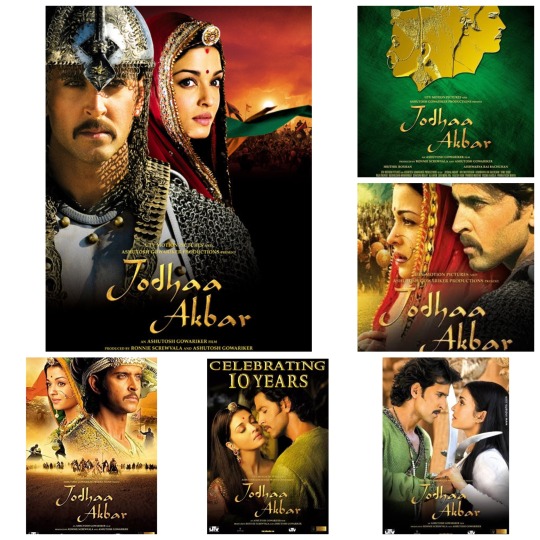
The words ‘Akbar’, ‘Jodha’ and ‘Mughal Empire’, whenever uttered in the context of Indian cinema, have been primarily associated with the all time classic ‘Mughal-e-Azam’. K. Asif’s epic directorial venture of 1960 has remained the benchmark of historical costume dramas in India since its release, not without any reason. Created on a budget of rupees 1.5 crore, considered mammoth six decades ago, Mughal-e-Azam continues to be the greatest Indian blockbuster of all time even today. It amassed roughly 11 crore rupees after its run at the box-office then, which is equivalent to about a massive 2000 crores now. Such is the film’s aura that substantial interest was generated among cine-lovers during the release of its coloured version even as late as in 2004 and 2009. Hence, those were enormous shoes that Ashutosh Gowarikar had to fit in; there was no way of escaping the comparison since the subject matters of both films were too closely related. And because it was Ashutosh Gowarikar, he succeeded.

Not only did he find the perfect story (courtesy of Haider Ali) and draft a soulful script with Haider Ali and K.P. Saxena, he also roped in musical maestro A.R. Rahman and poetic genius Javed Akhtar to take care of the ‘music and lyrics’, two attributes that were required to be absolutely flawless in a period film such as this. While Neeta Lulla’s costumes and accessories made every actor look the part, ace set designer Nitin Desai recreated the Agra and Amer forts at shooting locations with faultless precision. However, all of this could have gone to waste had Ashutosh not been able to get the perfect cast on board. Having Hrithik Roshan and Aishwarya Rai Bachchan as Mughal emperor Akbar and feisty Rajput princess Jodha respectively was nothing short of achieving an ultimate casting coup. And these two were going to be indispensable for the grand success of this colossal project, probably more so than anyone else, except the director himself.
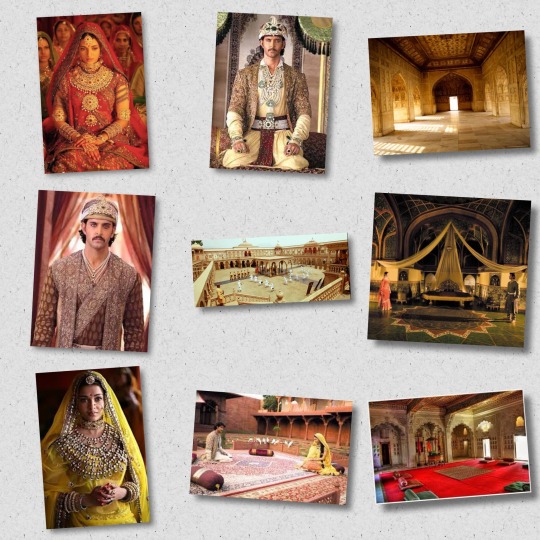
Hrithik Roshan might have already established himself as a terrific nuanced actor in the industry by the time he signed Jodha Akbar but taking on a role which would draw comparisons with the iconic Prithviraj Kapur and the legendary Dilip Kumar himself was a challenge he was yet to undertake. Likewise, Aishwarya Rai Bachchan, despite being the undisputed claimant to the title of the ‘most beautiful woman in the world’ during that time (which she still probably is) had never had her talent and beauty measured against the ethereal Madhubala before. Naturally, the burden of expectations lay as much on their shoulders as their director’s. The task at hand was going to be difficult for both but even more for Hrithik since he would be setting foot into the world of period films for the first time. His co-star had had previous experience from Sanjay Leela Bhansali’s Devdaas and Doug Lefler’s The Last Legion. The Last Legion in particular, deserves to be mentioned in this context because the sword-fighting training that Aishwarya had received for her role in that film probably helped her in Jodha Akbar too.
Despite not having the advantage of prior experience, Hrithik, like a true artist, owned the character of Akbar, making it seem like he had been playing historical characters all his life. His body-language, attitude, diction, voice modulation and movements were so attuned to someone of Akbar's stature that it took real effort to remember that the latter was a separate person. In a promotional interview before the film’s release, Ashutosh Gowarikar revealed how amazing an experience it was for him to see Hrithik get into the skin of the most famous Mughal of all time with an approach that was a combination of preparedness and spontaneity. Aishwarya too gave everything to the role of Jodha, and made this her career best performance since ‘Provoked’. Anyone who has watched ‘Jodha Akbar’ will agree that it is impossible to even imagine other people playing these two characters. If praise of the common man is not credible enough, let it also be known that Dilip Kumar saab himself was impressed by Hrithik’s versatility as an actor after watching the film at a special screening arranged for him by Ashutosh. He also admitted that the film had rekindled memories of the Magnum Opus ‘Mughal-e- Azam’ for him. Aishwarya too received immense praise for her performance as Jodha from critics, audience and industry colleagues alike.
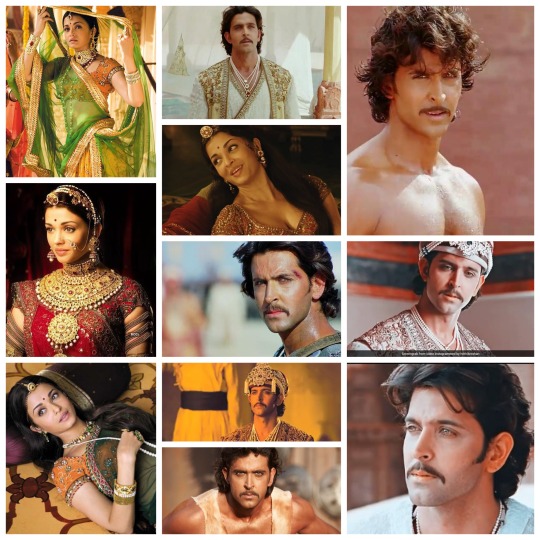
Although comparisons between Mughal- e- Azam and Jodha Akbar were inevitable, it must be noted that both films dealt with very different aspects of Akbar’s life. While the older classic was about the aged Akbar’s conflicted relationship with his son Salim over the latter’s love affair with Anarkali, a courtesan renowned for her exquisite beauty, Gowarikar’s Jodha Akbar depicted the love story between the young emperor and his first wife, the Rajput princess Jodha. The similarity between both films, apart from Akbar and the Mughals, lay in the fact that the identities of both Anarkali and Jodha had been a matter of contention amongst historians since decades. However, staying true to his meticulous nature, Ashutosh correctly issued a statement explaining that it was not his intention to disrespect any one; Jodha was one among the several historically mentioned names of Akbar’s Rajput wife and it had been chosen in the film over the rest due to its considerable popularity among commoners. Ashutosh was also very clear about the love story between Akbar and Jodha being completely fictional since no such account had ever been documented in history. Basically, the film was a fiction set against a historical backdrop, and as far as that setting was concerned, Ashutosh tried to be as accurate as possible, building a story around events that had been recorded in the Akbarnama.
Now that we have given the prelude, it is time to experience the film all over again, and we hope that prospect excites our readers. ‘Jodha Akbar’ opens with the second battle of Panipat that took place in 1556 A.D. between Mughal forces led by the child Emperor Jalaluddin Mohammad’s regent, Bairam Khan, and King Hemu. After defeating the latter, the Mughals were able to recapture the throne of Delhi. The war scenes are all flawlessly directed, keeping in mind the period and style of warfare adopted during that time, something that is naturally expected from a director whose resume boasts of films like ‘Lagaan’ and ‘Swades’. By the time Hrithik appears on the silver screen in one of the most challenging roles of his life, six years have elapsed and Jalal is an adult. Demonstrating his terrific grasp of the character, Hrithik sweeps the audience off their feet as Jalal finally sends Bairam Khan away to Mecca after stopping him from beheading the unarmed defeated opponent, and effectively takes over the administration of ‘Hindustan’ ('Ab apne faisle hum khud lena chahte hain'). Hrithik’s portrayal of Jalal’s suppressed rage as well as authority in this scene was a delight to watch then, and remains so even after all these years. As Jalal plans to annex the entire Rajputana, we are introduced to the other half of the film’s title, princess Jodha. Adept at sword-fighting, having learnt the skill from her cousin Sujamal (played beautifully by the talented Sonu Sood), Gowarikar’s Jodha is the perfect example of ‘beauty with brains’. Aishwarya is as graceful at sword-fighting as she usually is while dancing and imbibes the exact body language required to play a Rajput princess aptly.
Staying loyal to historical facts, Ashutosh Gowarikar depicts Jodha and Jalal’s marriage just as it actually was- a politically motivated alliance. Troubled by Jalal’s over-ambitious brother-in-law Sharifuddin, Jodha’s father, the King of Amer, requests Jalal to marry his daughter so that Amer could obtain Mughal security (In the film, Raja Bharmal of Amer sees Jalal for the first time as he tames a wild elephant in a superbly executed action sequence. Hrithik obviously did it himself, and in order to ensure his safety, he used to feed the said elephant regularly before the shooting of this particular scene took place). Her father’s decision comes as a rude shock to the young Jodha who does not want to compromise her culture after marriage, and is therefore left devastated. Despite not being completely sure about the proposal initially, Jalal eventually agrees to it in front of the Dargah of Khwaja Moinuddin Chisti as he realizes that this inter-faith marriage may be of assistance in promoting religious harmony throughout the country. In a beautiful monologue, he admits to the Khwaja that religious differences were the reason why previous rulers had not been able to establish their rule over the entire ‘Hindustan’; he believes his marriage with Jodha shall solve that problem.
However, Jodha’s decision is yet to come. She is not a stereotypical submissive sixteenth century female, unable to stand up for her own rights. Instead, she is brave enough to summon the Mughal emperor to her tent and lay two conditions in front of him, the fulfilment of which, is mandatory for her agreement with this new association (the famous ‘Humari do maange hain’ scene). First, she does not want to be forced into giving up her religion and customs; second, she wants a temple to be built inside her room in the Mughal palace for her spiritual guide, Lord Krishna. Aishwarya is enthralling in this scene; her calm yet rigid posture and polite yet bold speech are worth watching. Hrithik is simply magnigficent here; no other adjective is suitable enough to describe his phenomenal performance as Jalal hears Jodha out and later recounts the two demands to her relatives and rest of the entourage. He obviously goes on to accept these demands, his respect for Jodha increasing in leaps and bounds at her fearlessness and simplicity (‘Amer ki Rajkumari ke bekhawf jasbe aur saadgi ko hum salaam karte hain’). Naturally, Jodha has no other option left other than agreeing to the marriage.
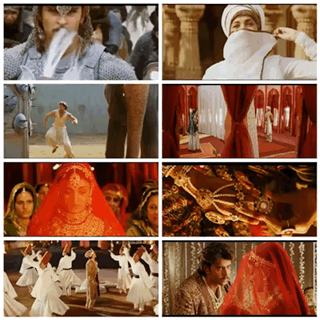
Had the director wanted, the wedding could have been an elaborate dramatic affair, but Ashutosh Gowarikar is not just another director looking for success through gimmicks. The grand wedding sequence lasts only for about a few seconds during which Jodha and Jalal wed each other as per both Hindu and Islamic traditions in an exemplary display of socio-religious amalgamation. Any extra time devoted to this would have been unnecessary and detrimental to the pace of the movie. After the wedding, a group of Sufi singers perform the utterly captivating ‘Khwaja mere Khwaja’, one of A.R. Rahman’s all time best compositions, in probably the most poetic Hindi film sequence of recent times. Such was its impact upon Mr. Bachchan that he termed it the ‘most apocalyptic moment’ in cinema since the great Stanley Kubrik’s ‘2001: A Space Odyssey’. It is not just the song that casts a spell upon the audience during this scene; rather, the direction and acting, in conjunction with the soulful music engender a near hypnotic effect among viewers which last in their minds forever. Hrithik’s expressions as Jalal experiences a spiritual epiphany and joins the Sufis in a trance are simply fascinating. He is a privilege to watch. The scene is an acting masterclass in itself and had he received every existing accolade for this moment alone, it would still not have been unfair.
Jodha and Jalal’s first night together is another instance of the subtlety that this film ceaselessly displays. Jalal, perceptive enough to understand that Jodha’s unyielding attitude towards his romantic gestures is not shyness in disguise, but unwillingness to be with him, has the perfect solution- she is free to leave him if that is what she wants. However, once again giving proof of her simplicity and honesty, Jodha directly confesses that she has no intention whatsoever of walking out of this relationship despite her inhibitions towards it; for her it is an unbreakable bond that shall last unto death. Respecting her wishes, Jalal vows to never be intimate with her against her will. Hrithik and Aishwarya’s acting styles truly compliment Ashutosh’s direction as is evident from this scene among many others in the film; without an ounce of melodrama, they are able to set the stage for an epic love story ridden not just with external impediments but personal inhibitions as well.
The rest of the movie is basically a collection of beautiful moments between the two leads, interspersed with an optimal amount of drama to propel the plot. The first sequence post their marriage that needs to be discussed in detail is the Deewan-E- Aam scene followed by the part wherein Jalal and Jodha see each other's faces without a curtain or ‘ghoonghat’ in between. As Jalal conducts his first hearing at the Deewan-E-Aam after his marriage to the Hindu Jodha, he, quite expectedly, faces opposition from the Ulemas of the court regarding his decision. However, before he is able to solve the problem at hand, the melodious voice of his newly wed bride distracts him, thereby interrupting the court proceedings. The expressions on everyone's face are worth watching as Jalal leaves his throne and begins to walk out of the court, clearly too engrossed to even officially dismiss everyone present. Realization hits him a bit too late, leaving him embarrassed in front of the entire Deewan-E-Aam, but he manages to salvage the situation by uttering an awkward 'Takliya'. This entire scene is once again a brilliant testimony to the skills of the director who expertly incorporates subtle humour in such a serious scene without overdoing any of it or making it seem farcical. Hrithik's performance here is admirable, his comic timing being absolutely flawless. Drawn by Jodha's entrancing voice, Jalal enters her 'Mahal' and they see each other for the first time in what was arguably the most romantic meeting sequence of Bollywood then and has been so since the last two decades. Ashutosh does not provide the actors with any dialogues here, who, therefore, rely completely on facial expressions to convey their feelings towards each other. Hrithik has been a master in expressions since he first entered the industry and in this scene, he is at his nuanced best. But Aishwarya is no less, and that is precisely why their interaction looks so natural and enchanting. With tiny eye gestures and body postures, they express admiration for each other's physical appearance, their eyes speaking a thousand words at once. The part where she wants him to put sindur on her, and he fails to understand initially, is such a wonderful portrayal of his willingness to understand and respect her culture that it strikes a chord with one and all.

For Jalal, it is almost love at first sight. Though completely smitten by her, he knows instinctively that Jodha is going to take more time, no matter how impressed she is with him. In the next few minutes, Ashutosh shows Jalal and Jodha gradually treading the first steps of love with Javed Ali's mellifluous voice ringing in the background. 'Kehne ko jashn-e-bahara hai, ishq ye dekh ke hairaan hai, phool se khushboo khafa khafa hai gulshan mein, chupa hai koi ranj fiza ki chilman mein'. When the inimitable Javed Akhtar is in charge of lyrics, songs get transformed into dialogues and help the story to march forward. Jashn-e-bahara does just that, and does so exquisitely. It challenges the notion that romantic scenes must always entail physical intimacy, and proves that sometimes a look or a smile is worth much more. Most of the credit for this should go to Hrithik and Aishwarya who defy every existing idea about screen chemistry by making heartbeats race even through mundane acts such as walking side by side while glancing furtively at each other, or smiling in embarrassment as they sit miles apart in a garden. Who says old-fashioned romance is always boring? When two individuals are able to set silver-screens ablaze by just standing together in one frame, every trivial action becomes exciting.
Scattered in between their light-hearted romantic moments during this prolonged sequence are two ‘more important’ ones. The first one depicts Jalal in an angry mood as he admonishes Maham Anga’s son Adham Khan when the latter dares to insult Jodha; as his awe-inspiring authoritative ‘Khabardar Adham, Rajkumari ka naam adab se lo. Ye na bhulo ki ab wo Malika- e- Hindustaan hain’ echoes through the silent night and reaches Jodha, she understands the extent of his respect for her and there is an expression of happy pride on her countenance. The second is probably everyone’s guilty pleasure and inspired multiple ‘tele-serial adaptations’ back in the day; while Jalal practices moves with the sword bare-bodied, Jodha suddenly catches sight of his chiselled body and cannot stop staring. In a brilliant directorial move, Ashutosh makes her put the plate of worship down so that she can actually concentrate on the view better 😂😁🤩🤩. Aishwarya is terrific here, portraying Jodha’s attraction to her husband perfectly although in an extremely nuanced manner. Of course when the man in question is Hrithik Roshan, it helps. Jalal is shrewd enough to notice his ‘wifey dearest’ and catches her off guard by turning around suddenly after which the poor girl hastily draws the curtains. Hrithik’s mischievious look is a treat to eyes! But seriously, how mean of him to intrude upon his wife’s private moment of ‘adoring her husband’ that way?🤪🤪

Being one of the best directors in the industry, Ashutosh Gowarikar ensures that his film contains the right mix of romance and drama. The first instance of drama in the movie since the wedding is provided by Maham Anga, Jalal’s ‘Badi Ammi’ (played by the exceptional Ila Urun) a politically shrewd woman, whose possessiveness for her foster son and displeasure at the advent of a strong-willed intelligent Rajput princess into the fort of Agra makes her vindictive towards the said person. When Jodha decides to prepare authentic Rajput food herself after Jalal orders a ‘Rajputi Daawat’ on the day of ‘Peer’ in her honour, Maham Anga spews venom at her through harsh words and accuses her of trying to establish control over the kitchen, and eventually Jalal himself. Jodha, although shocked, gives her befitting replies, and ultimately completes the entire cooking by herself. The scene that follows could easily have been a disaster if it had been handled by an ordinary director; it could have been an excruciatingly slow and boring sequence testing the patience of the audience. The fact that it is one of the most interesting parts of the entire film is a measure of Ashutosh Gowarikar’s genius. Substantial credit must also be given to the actors including supporting ones without whom Ashutosh might not have been able to produce the desired outcome in this scene ultimately. However, this scene belongs to Aishwarya Rai Bachchan. Her shock at being insulted by Maham Anga when she asks her to taste the food before serving it to the emperor, rage as she turns to her husband for support, and suppressed anger as well as sadness when she realizes that there is no way out are nothing short of mesmerizing. Her genuine happiness when Jalal decides to have food from the same plate she has eaten and her sly look towards Maham Anga are a sight to behold. Truly, Aishwarya is probably one of the most underrated actresses in our industry; she is fantastic but does not always get the due credit for it. Most of the time, it is her beauty and personality that gets talked about. Nevertheless, she is a terrific actress too and we sincerely hope people acknowledge that more often. Hrithik supports her fascinatingly throughout the scene, his eyes showing anger, helplessness and embarrassment at his wife’s insult flawlessly. It is the mark of a great actor to allow his co-actors to soar when the scene requires so. In an old interview, while explaining why Aishwarya was his favourite co-star, Hrithik said that they had very similar working styles which made them more compatible with each other; according to him, both of them were more concerned with the larger picture, and did not care if they were being given importance in every frame or not. This particular scene is the perfect example of that working style he was talking about.

The ‘Rajputi Dawat’ sequence changes something between Jodha and Akbar; they have managed to cross that initial threshold of hesitation towards each other. However, just when they are gradually coming closer, circumstances and people pull them apart. When Adham Khan murders one of Jalal’s most trustworthy ministers, Shamsuddin-Muhammad-Atgah-Khan, and intrudes into the emperor’s personal premises with a sword, the latter tackles him and orders royal guards to throw the traitor with his head downwards into the ground below. When he is only half dead after the first fall, Jalal, showing his cruel side, orders his soldiers to bring Adham up to the roof so that they can throw him down again. Future generations will remember Hrithik for this scene among many; he is spectacular here with a stance that is completely majestic and a face that exudes rage and grief in equal measure. He was actually able to generate tangible fear amongst the audience back when the film had released; we still remember the collective gasp at the theatre during this scene. This is also the first time Jodha gets acquainted with Jalal’s darker side. Until this moment, she had known him as a gentle, understanding young man; now she sees him as capable of being cruel to someone. Aishwarya’s portrayal of fear is spot on and subtle with no melodrama whatsoever, for which the director also deserves praise.
The next scene had actually been deleted from the movie to manage its length but we genuinely feel it should have been included due to its significance. Horrified at Jalal’s action, Jodha confronts him in a terrific angsty sequence only to realize that Jalal is mourning the loss of a father figure in Shamsuddin-Muhammad-Atgah-Khan. Hrithik is superlative as Jalal breaks down and confesses to his wife about being orphaned again. This is the most tender moment both have yet experienced, and that realization is clearly etched upon Jodha’s face, who gives her heart-broken husband sound advice. She understands why he killed Adham, but asks him to apologize in front of Maham Anga, despite all the troubles the latter has created for her. We surely would not have minded sitting in the theatre for a few extra minutes to watch this brilliant scene Mr. Gowarikar!
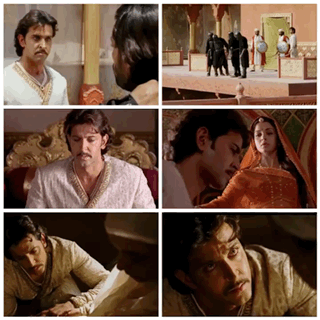
The scene wherein Jalal explains his behaviour to Maham Anga is one of the most important sequences in the film for multiple reasons. Firstly, the acting is phenomenal; emotions have always been Hrithik’s forte and what do we say about Ila Urun? We are probably not qualified enough. So, its better to just bow our heads in respect and keep quiet. Second, this is when Maham Anga is able to instigate Jalal against Jodha by feeding him false information. She shows him a container of poison that her spy had extracted from Jodha’s personal belongings earlier and lies that his wife may be planning to harm him. In reality, Jodha’s mother had given her the poison so that she could kill herself if she feared of being dishonoured by her husband after the marriage. Maham Anga also misleads him by talking about a letter that Jodha has written to Rajkumar Ratan Singh, the Rajput prince, she had been betrothed to since her childhood. This letter had actually been written by Jodha to her cousin Sujamal, who had left Amer after being denied the throne. In the letter, Jodha had requested him to rescue her from being married off to the Mughal emperor. However, she had never sent it. After finding it in Jodha’s room, Maham Anga sends it to Sujamal, to take advantage of the situation and create a rift between Jalal and his wife. Unfortunately, this diabolical ploy works because of Jalal’s blind trust in his ‘Badi Ammi’. Upon receiving the letter, Sujamal believes it to be genuine, and goes to the Agra fort at night without caring about the risk. Jodha comes out to meet him, surprised at this sudden visit, but assures him that she is happy with Jalal. To her misfortune, her husband, who has never seen Sujamal or Ratan Singh before believes the intruder to be the latter and sends soldiers to capture him. Sujamal escapes, but only after thinking that Jodha deliberately called him there to be arrested. Meanwhile, Jalal accuses her of plotting with Ratan Singh behind his back. Outraged and shocked at this humiliation, Jodha tells him that Maham Anga is the one who has caused this entire misunderstanding. When Jalal refuses to believe her, she asks what punishment he has in mind. And, he tells her to go back to her parental house! Jodha naturally feels terribly insulted at his decision, and decides to leave him and protect her self-respect! This is a wonderfully executed sequence with the two leads reacting to each other masterfully, and turning it into one of the best angsty interactions ever. This was also the moment that Ashutosh chose as the point of intermission, a sound decision obviously because to be very honest, by this time the audience was indeed in need of some food and drinks 😄😄. On a serious note, this was a watershed moment in the lives of our two lead characters, and a perfect opportunity to take a break and come back refreshed.
Any analysis of Gowarikar’s Jodha Akbar is bound to be elaborate simply because it is impossible to designate any scene from the film as unimportant or bad. It is not for nothing that we termed this film a masterpiece at the beginning of this blog. Every second of it is still a pleasure to the senses and deserves mention. However, for the purpose of your sanity and ours (not to mention the time constraint), it is vital that we take an ‘interval’ too, and analyse the second part of the movie in a separate blog. Don’t worry, we will not take too long. So au revoir as the French say ; hopefully you will bestow your good wishes upon us once again like you have till now.❤️❤️
15 notes
·
View notes
Text
An Analysis of The Ninth Gate
I finally got around to watching The Ninth Gate after it was recommended on Occultism with a Side of Salt. Seriously, why did it take me so long to watch this film? This is pretty much everything I like! It’s a film from 1999 (incidentally, the same year as Eyes Wide Shut) starring Johnny Depp as an expert on rare books called Dean Corso. It’s based loosely on a novel by Arturo Pérez-Reverte called The Club Dumas, and was directed by Roman Polanski (who’s the man behind Tanz der Vampire, but who is extremely problematic and we do not stan). Corso is employed by a rich book collector named Boris Balkan to authenticate his copy of a grimoire called The Nine Gates of the Kingdom of Shadows, which may be the coolest title for a grimoire ever. The book is supposedly designed to summon the Devil himself, and was copied from another mysterious book that the Devil was said to have written. Corso compares the grimoire with the two other existing copies to find out which one is the real one, but there are mysterious deaths and other unsettling events around the book, and he has a mysterious girl helping him.
The film is very spooky and has a wonderful Dark Academia aesthetic. What’s most interesting to me about it is, although it isn’t authentically occult, it feels very authentic. The grimoire is clearly modeled after real ones. The engravings in the book also could easily be mistaken for real ones if I didn’t know better. I think that the pentagram on the cover is a little too on-the-nose, especially since pentagrams weren’t associated with Satanism until relatively recently — I think the Sigil of Lucifer would be a better fit, since it’s reasonably well-known (for example, the Mother Superior of the Satanic Nuns in Good Omens wears one instead of a cross) and it comes from a real grimoire. That’s me being very nitpicky, though. Although this film follows some tropes of Hollywood Satanism, its portrayal of that is still more realistic than normal. Real-life occult ritual groups are more like book clubs or potlucks, but the actual ritual part can in fact look something like the one in the film. (Sure, it wouldn’t be in a mansion with cool-ass gargoyles, but this is certainly more realistic than Eyes Wide Shut.)
This film feels authentically occult becuase a lot of real occultism is pouring over old books and analyzing symbolic images. I do a lot of that! Right now, I’m reading a dictionary of alchemical symbolism. I hope to eventually be able to look at all the weird images in alchemical manuscripts and make some sense of them. This film is basically about doing exactly that. I noticed the tarot symbolism in the engravings immediately, and I felt a little like I was trying to decipher them right alongside Corso. It reminded me of solving Nox Arcana puzzles, and that just makes me incredibly happy. The approach this film takes is also realistic — (slight spoilers) it could have gone the classic Hollywood route of summoning Satan to destroy the world and all that, but it doesn’t. Instead, the end goal is more abstract and spiritual, much more in-line with occultists’ actual goals in real life. Just as in alchemy, the goal is not to make gold or live forever, but to experience spiritual transcendence, and this is encoded in alchemists’ notes and artwork.
So, I want to try my hand at deciphering the engravings’ secrets, and test my own knowledge of occult symbolism in the process. Everything that follows involves major spoilers, so I will dispense with the exposition and assume that you have already seen the film.
I’ve seen it argued on YouTube that the engravings represent actual events in the film, and some of them seem to. Bernie is murdered and hung upside down, the collapsing scaffolding is the “danger from above” arrow, Corso is hit in the back of the head in one of the film’s most chilling scenes, and the Girl (who is implied to be Lucifer) ends up… well… “riding” him in front of the burning castle. But come on, that is way too easy. For one thing, the related events don’t seem to occur in any specific sequence, either the engravings’ numbered sequence or Balkan’s rearranged sequence. It would make sense if Corso would have to experience every engraving and “pass through each gate” — that happens a lot in films like this one, where an eerily coincidental series of events plays out just as in the book/prophecy/whatnot. But that doesn’t really happen, or if it does, it’s not obvious enough for the only interpretation of the engravings to be literal. What impresses me the most about The Ninth Gate is that it goes for that more figurative, spiritual dimension. That is really what makes it feel realistically occult.
The real solution to the engravings seems to be spiritual growth or enlightenment, which is the goal of most occultists. Balkan sort of understands this, which is why he disdains Telfer and her coven being edgy and playing dress up instead of really making an effort to understand Lucifer’s secrets. And yet, Balkan also fails, because he is after power, not enlightenment. It seems as though both of them misunderstand Lucifer, believing him to be the kind of Lucifer that you usually see in these movies. (That would fit in well with his name and his role in the Eden story, if you interpret it that way.) If we assume that the Girl is Lucifer, then she is more benevolent an influence than anything else. Hell, Corso doesn’t even suffer any “temptation” consequences from having sex with her. Corso wins in the end because he actually puts in the effort, and the Girl helps guide him toward enlightenment. Maybe Lucifer is a good force in this film’s world. Lucifer’s own versions of the engravings seem to emphasize that s/he is genuinely invested in helping his/her followers towards enlightenment.
When Balkan assembles the engravings in the proper order, this is his interpretation of the riddle:
To travel in silence, by a long and circuitous route, to brave the arrows of misfortune, and fear neither noose nor fire, to play the greatest of all games and win, foregoing no expense, is to mock the vicissitudes of fate and gain at last the key that will unlock the Ninth Gate.
First, I want to say that this riddle reminds me a lot of the Emerald Tablet. It’s similarly cryptic, and I only sort of have it figured out. I love that something like that is real and authentically ancient. Anyway, moving on. I’ll go through the engravings in the order that Balkan puts them in (as opposed to their numbered order), and see if I can make sense of them.
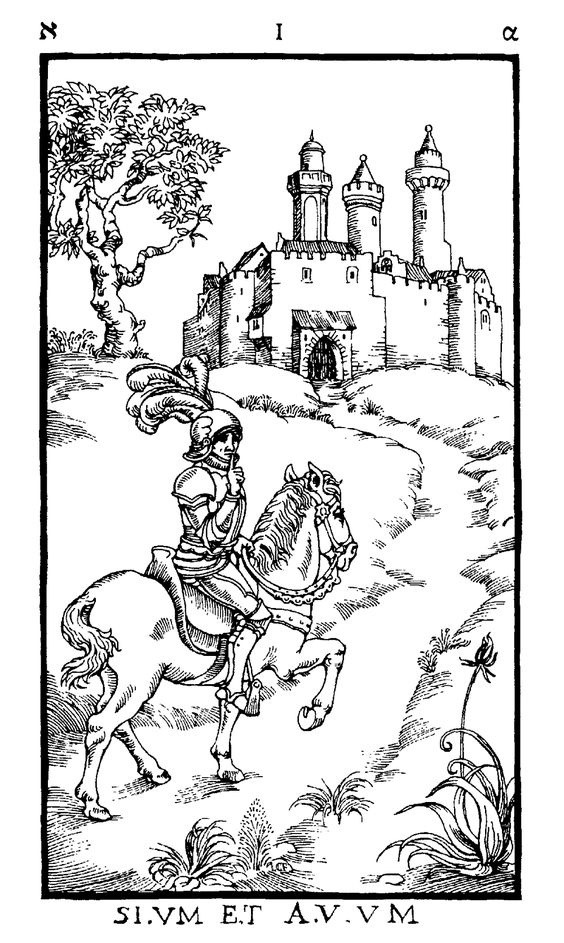
The first engraving shows a knight traveling towards a castle. In the AT version of the engraving, the castle has four towers, while in LCF’s version, it has three. Balkan’s interpretation is “To travel in silence,” while the caption is “Silence is golden.” That immediately reminds me of the common occult maxim, “To Know, to Will, to Dare, to Keep Silent.” I’ve never been much of a fan of keeping silent, which is why I post things like this on the internet, but in general occultists tend to be secretive folk. According to this article, another translation of the caption is “Only one who has battled according to the rules will prevail.” I’m not sure whose rules are being referred to here. Lucifer’s, maybe?
This is one of the only engravings in which there is no obvious tarot symbolism. There are four Knights in tarot, one for each suit — wands, swords, cups, and pentacles — but this knight doesn’t have a symbol of any of the suits or anything that could suggest that. The difference is in the castle towers — three in LCF’s, four in AT’s. In traditional numerology, three is a number symbolizing perfection and creation, as in the Holy Trinity, while four is the number of the solid and material and unlucky. (Source: Richard Cavendish, The Black Arts). Sets of three are especially common in fairy tales and mythology — three siblings, three tasks, three encounters, three magical objects, three questions, three trials or tests, repeating an action three times with the third time being different or conclusive, etc. Lucifer’s castle at the end also has three sets of towers. The most obvious interpretation of this is that your destination will be either material gain (AT) or spiritual advancement (LCF).
In the tarot, the threes represent the completion of the first stage of a venture — the Three of Wands represents a successful enterprise, the Three of Cups represents celebration and fulfillment, and the Three of Pentacles represents recognition for your achievements. All of them have something to do with attainment except for the Three of Swords, which represents loss, heartbreak, betrayal, etc. The fours aren’t bad, representing stability and structure — the Four of Wands is joyful and peaceful, the Four of Swords takes time to rest and recoup, the Four of Cups is bored and listless, and the Four of Pentacles receives material abundance. All of them are a bit more grounded and material, so I think it makes the most sense to interpret the difference in this engraving as being the spiritual three vs. the material four, and leave it at that.

The fourth engraving, which is second in Balkan’s sequence, is of a jester standing at the entrance to a labyrinth. In LCF’s version the labyrinth’s exit is open, while in AT’s it is bricked up. Balkan interprets this as meaning “by long and circuitous route,” while the caption reads “Fate is not the same for all.” that seems fairly straightforward — Balkan and Corso have different fates. Corso is able to find his way out of the Labyrinth, but Balkan’s exit is bricked up. This is because he never properly experienced the journey the way Corso did, he just wanted the payoff and tried to take shortcuts.
The Labyrinth is a very old symbol, and it carries the dual symbolism of a death trap in which there is a Minotaur, and a path to spiritual enlightenment. It can represent the Underworld or the darkness of the subconscious mind, with the Minotaur being your Shadow. Either you are trapped in the Labyrinth and eaten by the monster, or you find your way back out into the light having gained some self-awareness. The jester is probably meant to represent 0 The Fool, who, in the Tarot, is the naive adventurer who sets out on a spiritual journey over the threshold and into the realm of the subconscious and symbolic — i.e. the Labyrinth. As for the dice in the foreground, this seems to reinforce the caption’s point about fate. But dice, like tarot cards, can be used as both a game and a divination tool — it is the assumption of the diviner that random chance is always meaningful. And indeed, the visible faces on each die add up to 6 — 666.

The third engraving depicts a traveler walking towards a bridge. In the clouds above him, there’s a Cupid-like figure with an arrow pointing down at him. Balkan’s interpretation is “to brave the arrows of misfortune,” and the caption is “The lost word keeps the secret.” AT’s version is pictured here; in LCF’s version, there are two arrows, the other one pointing upwards in the quiver.
This traveller looks much more like the traditional Tarot depiction of 0 The Fool than the jester. The Fool is happy-go-lucky and doesn’t notice the danger he might be walking into. TV Tropes describes The Fool trope as referring to a person who, despite having no idea what they’re doing, doesn’t come to any harm because of their luck and innocence. So, the traveler will probably not be hit by the arrow, the same way Corso avoids the collapsing scaffolding. The two arrows in the LCF version seem to reinforce the idea of there being two possible outcomes. The arrow pointing up and the other one pointing down could also reference the famous occult maxim, “As above, so below,” adding another spiritual dimension to it. Balkan’s interpretation of the engraving reminded me a lot of a certain famous soliloquy: “To be or not to be, that is the question: / Whether ’tis nobler in the mind to suffer / The slings and arrows of outrageous fortune, / Or to take arms against a sea of troubles / And by opposing end them.” In this scene, Hamlet is considering whether or not to take his own life. But when applied to this engraving, these lines seem to once again suggest the two possible outcomes — you can suffer and die, or move on towards your goal.
And then there’s the caption. “The lost word keeps the secret.” Well, it’s pretty obvious what that refers to — the ninth engraving, replaced with a forgery that changes the meaning of the entire thing. The missing engraving contains the secret. But that caption seems completely irrelevant to this engraving, except that the face of the archer doesn’t look remotely like a baby’s, as putti usually do — it looks like an old man’s, specifically, the Ceniza brothers’, who removed and replaced the missing engraving.

The sixth engraving, fourth in Balkan’s sequence, depicts a man hanging upside-down by his ankle, and an arm with a flaming sword reaching out of a castle tower. Balkan’s interpretation of this is “and fear neither noose nor fire,” which proves he knows fuck all about tarot. No wonder he got the riddle wrong. This one is so blindingly obvious. The man isn’t hanging by his neck, he’s hanging by his foot. He’s the Hanged Man.
XII The Hanged Man is a strange and disturbing card at first glance, but it has become one of my favorites. The Hanged Man is almost never depicted hanging by his neck; he hangs by his foot, and has a serene expression, indicating that he wants to be there. He represents going through a period of tribulation, suffering, surrender, or introspection in order to obtain wisdom, enlightenment, self-awareness, and insight. He goes through a metamorphosis, just like the caterpillar that hangs upside-down in its chrysalis to become a butterfly. He’s a Christlike figure, evidenced by the halo around his head in the Rider-Waite deck, and the fact that he willingly suffers for a higher purpose. He even wears the same colors as Jesus in Da Vinci’s The Last Supper in the Rider-Waite deck, although I’m not sure if that’s on purpose or not.
The caption to the engraving is “I am enriched by death,” which is a million times more meaningful than Balkan’s interpretation. If you’re an occultist, that line is probably self-explanatory. Pretty much everything mystical involves that theme of (symbolically) dying and being resurrected. The alchemical process has three stages — nigredo, which is death, albedo, which is the ascension of the soul, and rubedo, which is returning to life in a “purified” body as a more spiritual being. The Hero’s Journey follows this same pattern — the hero entering the Underworld or the Labyrinth and facing trials that allow them to spiritually ascend and achieve apotheosis (or something close to it). It’s everywhere in books, movies, and video games. It is the initiation ritual. Most occultists figuratively go through it in one way or another. And in tarot, XII The Hanged Man is at the rough midpoint of the Fool’s journey through the Major Arcana, and immediately followed by XIII Death. “I am enriched by death.” You cannot be reborn as a new and better version of yourself without first having died.
The difference between AT’s and LCF’s engravings is that AT’s has the Hanged Man hanging by his right foot, while LCF’s has him hanging by his left foot. I don’t think this changes the meaning of the engraving too much. In Rider-Waite, the Hanged Man hangs by his right foot, but in the Tarot de Marseille, which is older, he hangs by the left foot. The only significance to this that I can see is that the Latin word for “left” is sinistram, and the word “sinister” has its current meaning because left was considered Satanic. Left-handed people were discriminated against for this reason, until as late as the mid-20th century. In occultism, the “Left-Hand Path” is an approach to magic that involves rejecting tradition and dogma and generally being edgy. I think that the right-hand and left-hand paths are a false dichotomy (you use both your hands, don’t you?), but anything Satanic is considered part of the Left-Hand Path. Jung associated left with the unconscious, so we’re back to the Labyrinth.
I don’t have much to say about the flaming sword. It could be foreshadowing Balkan’s death (more on that later), or it could represent the flaming sword of the angel of Eden (i.e. guarding spiritual knowledge).

The seventh engraving, fifth in Balkan’s sequence, is of a king and a peasant playing a chess game. Two dogs are fighting in the background, and the moon can be seen through the window. In AT’s version, the board is black, and in LCF’s, the board is white. Balkan interprets it as “to play the greatest of all games,” and the caption is “The disciple surpasses the master.”
The tarot symbolism that I see here is that of XVIII The Moon, which has dogs baying at it in the Rider-Waite deck. The Moon represents the subconscious, imagination, and dreams, but also nightmares, madness, and illusion. The illusion here is probably still the missing engraving being replaced by the forgery. The themes of the subconscious get reinforced. Underneath the Moon, a black dog and a white dog fight each other, almost seeming to create a yin/yang shape. This brings the dark and the light into balance, the same way the Moon spends equal times dark and bright as it goes through its phases. The game is chess, which is played with black and white pieces, and the board is either black or white. The game seems to be a draw, making the peasant and the king equals, just as the dogs are unable to defeat each other. So, this engraving is all about reconciling dualities.
There’s another layer to this. God is the “King of Kings,” so this could demonstrate a human becoming God’s equal. This is basically the goal of occultism — to become like God, in some form. Left-Hand Path’ers in particular seem to like the idea of becoming gods themselves, or even “surpassing” God. Since the book was created by Lucifer, this could tie in to Lucifer’s desire to become God’s equal that got him cast out of Heaven (but I’m not the biggest fan of that story, so I won’t go any further with that). To the occultist, man is God, just as God can become a man — as above, so below. That’s also a form of reconciling the duality of human and divine.
The caption, “The disciple surpasses the master,” probably refers to this, but it could also refer to Corso surpassing Balkan and succeeding where Balkan failed. Any good teacher wants their students to have learned so well that they surpass them. God (or Lucifer) intends for his disciples to surpass him, but Balkan tries (and fails) to prevent Corso from surpassing him.

The fifth engraving, which is sixth in Balkan’s sequence, depicts a man counting coins while Death stands behind him with a pitchfork and hourglass. Balkan’s interpretation is “and win, foregoing no expense,” while the caption reads “In vain.” Balkan is an idiot. Exactly like the man in the engraving, he is focused entirely on the money and completely misses the literal shadow of Death standing behind him. How does one overlook the significance of that? There’s a big difference between “I won the game so now I get money” and “in vain”! Of course, this means that Balkan is too focused on material pursuits and misses that he is about to die. In AT’s version, the sand is at the top of the hourglass, while in LCF’s version, it is at the bottom — the man has run out of time. The expression “you can’t take it with you” comes to mind. Money and material goods don’t ultimately matter compared to spiritual growth. “In vain.”
In tarot, XIII Death almost never represents physical death. Instead, it represents change, usually a change for the better. Death is about letting go of old things so that new things can come, stepping through a threshold into another life or state of being. This can be difficult or emotionally painful, but it is necessary and ultimately beneficial. If The Hanged Man is the chrysalis, then Death is the emerging butterfly (the Greek word psyche means both “soul” and “butterfly,” because butterflies represent the souls of the dead). Once again, Death is a required step towards spiritual advancement. And if you refuse to acknowledge this, it isn’t going to go well for you.
The checkerboard floor probably continues to reinforce the theme of duality. As for the pitchfork, maybe the reason Death has a peasant’s pitchfork instead of a scythe is because pitchforks are associated with Satan, or it could be a representation of peasants taking revenge on rich people. Or it could be a reference to American Gothic. I think it’s the first one.
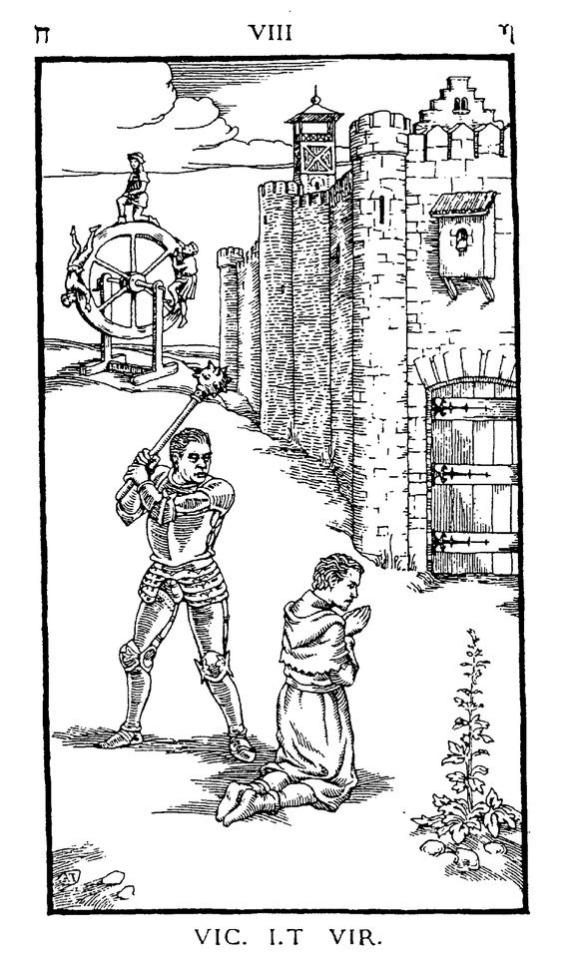
The eighth engraving, which is seventh in Balkan’s sequence, depicts a praying man about to be bludgeoned by a knight with a mace, with the Wheel of Fortune in the background. Balkan’s interpretation is “to mock the vicissitudes of fate” and the caption says “Virtue is defeated.”
The Wheel of Fortune is a medieval motif that shows how fortune is apparently random. Some get to be kings, others are serfs, and your fortunes can turn at any moment. Just when you think everything is great, someone hits you on the back of the head. In tarot, X The Wheel of Fortune means exactly what you would expect it to — a twist of fate, a change of fortune. Whether it’s for better or for worse depends on the context and the cards around it. Life is full of ups and downs, so enjoy what you’ve got while you have it, etc. Sometimes when it shows up, it can mean that you should trust in fate.
But that’s the background. What to make of the foreground? Honestly, this is the most disturbing engraving to me, especially with the accompanying scene where Corso gets hit in the head. By whom? It’s probably Telfer’s lackey, because the knight in the engraving kind of looks like him. And if the caption is “Virtue is defeated,” the praying man hasn’t been defeated yet. The knight is about to hit him, not already standing over his body. It could be an example of “bad things happen to good people” — being virtuous won’t stop you from suffering. Since Corso is the one who gets hit in the back of the head, maybe that indicates that he’s the most virtuous character (which is saying a lot, since he’s not exactly an upstanding person). In LCF’s version of the engraving, the knight has a halo — does that mean that defeating Virtue is a good thing? I guess that would make sense if the artist is Satan? Or does it mean the knight is protecting the praying man? I don’t know. I genuinely am not sure how to interpret this one. What I do know is that Balkan is still an idiot. Nothing about this suggests mocking fate. If anything, this is an example of succumbing to it.
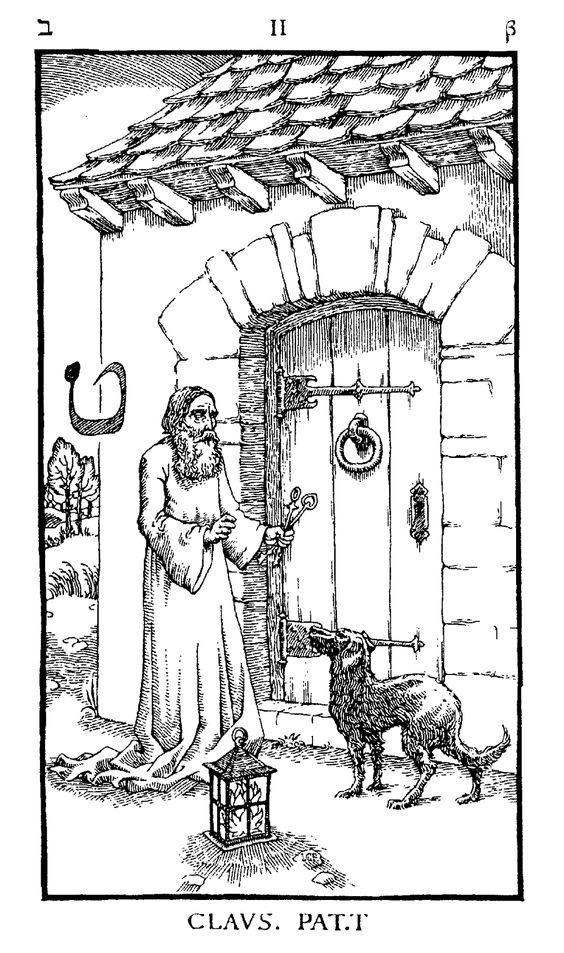
The second engraving, eighth in Balkan’s sequence, shows an old man with a dog, holding two keys in his hand. In AT’s version, the keys are in his right hand, and in LCF’s, they are in his left hand. Balkan’s interpretation is “gain at last the key,” and the caption is “Open that which is closed.”
This is another obvious tarot image. This is clearly The Hermit with his lantern. IX The Hermit represents withdrawing into solitude for contemplation and meditation, to gain spiritual wisdom and awareness. Like the Hanged Man, he indicates a need to be passive in the service of introspection. He’s the archetypical guru on a mountain, and he holds the keys to enlightenment. Keys represent access to information, and the ability to pass between worlds. “Open that which is closed” is pretty obvious — unlock the gates, receive spiritual insight. LCF’s version having the keys be in the left hand just reinforces everything I said about left earlier.
Also, that Hebrew symbol next to him is the one for the number nine. That suggests that the Hermit is right in front of the Ninth Gate. In numerology, nine is a magical number, being three times three. It represents completeness, spiritual achievement, and initiation. So, that’s self-explanatory. In tarot, tens are the ultimate state of completion, so the nines are the penultimate step — the Nine of Wands gives you the strength and willpower to overcome obstacles, the Nine of Cups represents success and contentment, and the Nine of Pentacles represents celebrating an accomplishment. (Once again, the Swords are the outlier, representing fear and despair.) Nines in general are good, the perfection of three multiplied by itself. (The Hermit is also the ninth card of the Major Arcana, if you noticed.)

And finally, we come to the ninth and final engraving (that Roman numeral should read “IX”). This depicts a woman who looks suspiciously like the Girl reading a book, ostensibly The Nine Gates of the Kingdom of Shadows, and riding a dragon with seven goatlike heads. There is a castle in the background, and the castle is a real place. There are three versions of the engraving — this one, which is signed by AT and has the castle as-is, a forged LCF engraving that shows the castle in flames, and the real one. Balkan’s interpretation is “that will unlock the Ninth Gate,” and the caption is “Now I know that from Darkness comes Light.”
The woman is apparently an image of the “Whore of Babylon” from Revelations, who rides a seven-headed dragon. I’m not really sure what she’s supposed to represent, beyond being generally Satanic. Of course, Crowley recasted her as a sex goddess. The seven heads of her dragon are significant — seven is the number of secrets, mysteries, magic, introspection, and searching for inner truth, which have been running themes this whole time. It also signifies creation, completeness, and rest, since God created the world in seven days. In tarot, the sevens present a new challenge after the perfection of the sixes — the Seven of Wands brings new obstacles that require determination to overcome; the Seven of Cups represents imagination, dreams, and illusions, so back to The Moon again (and the illusion of the forgery); the Seven of Swords also represents deception or a con artist (like the Ceniza twins, or maybe Balkan); and the Seven of Pentacles represents a threshold or a new opportunity, and reflecting on one’s achievements. That all aligns scarily well with the situation here.
The critical illusion is that the “LCF” engraving with the burning castle is a forgery. So, Balkan sets himself on fire for no reason other than egomania. This image is similar to XVI The Tower in Tarot. The Tower is one of the scariest cards to get. If Death is a difficult but beneficial change, The Tower is a dramatic turn for the worse, complete destruction and devastation. It is struck by lightning and destroyed, going up in flames. I drew this card shortly before the pandemic hit. That was The Tower — destruction, upheaval, devastation, but with the promise of rebuilding. I also had to deal with a lot of emotional turmoil because of an unrelated thing that happened around the same time, and it shook me to my core. So, obviously the forged engraving leads to Balkan’s destruction.
The true ninth LCF engraving shows the sun shining from behind one of the castle’s towers:

Replacing The Tower with The Sun is a drastic difference. If The Tower is one of the worst cards to get, XIX The Sun is one of the best. The Sun is a good omen in every capacity. It represents everything that these engravings have been working towards — spiritual growth, fulfillment, success, enlightenment, revelation of secrets, good fortune, etc. It fits right in with Lucifer’s status as the Light Bringer, and it is the solution. (The true engraving is also very reminiscent of The Star, which directly follows The Tower, and represents hope and the light at the end of the tunnel. I drew it recently, signifying the end of my emotional turmoil.) The jagged rocks at the bottom of the castle in the other two versions are missing here, and the castle is more accessible, with a visible path. The woman gestures directly to it.
The rest of the scene is much more shadowed in the true version, which fits right in with the caption: “Now I know that from Darkness comes Light.” I, in my obsession with Shadow work, interpret this as confronting the dark parts of oneself and bringing them out into the light to become a whole person, and to grow spiritually. This goes back to the Labyrinth, needing to enter the dark Underworld or the realm of the subconscious in order to gain spiritual wisdom and finally achieve enlightenment. Everything in the engravings seems to point back to that — needing a period of introspection, reconciling of duality, obtaining safe passage through the various trials until you see The Sun, which is followed by Judgement (resurrection) and The World (fulfillment). The Nine Gates of the Kingdom of Shadows are like the seven gates of the Underworld that Inanna must pass through (and that eight-pointed star is a symbol of Inanna). Corso passes through the Ninth Gate, out of the Kingdom of Shadows and into the light.
Balkan’s interpretation is clearly off. So, let’s rearrange the engravings back into their intended order:
Silence is golden. Open that which is closed. The lost word keeps the secret. Fate is not the same for all. In vain. I am enriched by death. The disciple surpasses the master. Virtue lies defeated. Now I know that from darkness comes Light.
If you, who seek after secrets, wish to unlock the gates to wisdom and enlightenment, be wary of potential dangers and missing pieces. You can either suffer and die, or move towards your goal. You will either find a way out of the Labyrinth or find that your path is blocked. Do not pursue material gains, and miss the shadow of Death hanging over you. Face Death, and you will be enriched by it, gaining spiritual insight that will allow you to surpass your superiors and become God’s equal. After a final challenge, test of virtue or twist of fortune, you will emerge from the darkness and into the light.
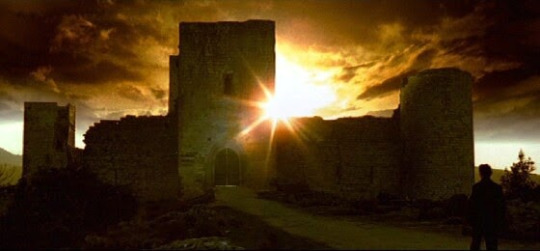
Am I reading way too deep into a spooky movie? Maybe, but come on! How could I resist? Do any of you have interpretations of your own?
Sources:
https://slapphappe.wordpress.com/2009/03/22/symbolism-in-the-ninth-gate/#%3A~%3Atext%3DThe%20fire%20at%20the%20Ninth%2Cof%20the%20Kingdom%20of%20Shadows.
https://davidjrodger.wordpress.com/2011/08/24/the-ninth-gate-occult-and-tarot-like-symbolism-in-the-engravings-by-aristide-torchia-and-lucifer-plus-wider-meanings-of-the-movie/
#the ninth gate#the ninth gate film#johnny depp#johnny depp movies#occult#occultism#occult symbolism#tarot#tarot symbolism#occult symbols#movie analysis#spooky#dark academia#dark acadamia aesthetic#occult films#lucifer
11 notes
·
View notes
Text
FTWD 6x15: U.S.S. Pennsylvania - Analysis
How did everyone like this episode? I liked it a lot, and basically what happened is what we’ve been predicting for several weeks, now.
***As always, spoilers abound for 6x15 below. Don’t read until you’ve watched!***

I said that they would probably set off one of the nukes, but not all of them. Clearly, it wasn’t going to be a nuclear holocaust or anything, because the TWD storyline is 6 years in the future compared to Fear, and we haven’t seen anything like that.
But in the end, they launched 1 missile that has 10 warheads on it. And Teddy specifically said it might be heading toward water. So we’re right on track with the idea of them poisoning the water this way.
Okay, let's get into details. We start with the wind blowing, and showing the church doors waving back and forth, and a rusted, decrepit merry-go-round. All of these things are foreshadows of what is going to happen. The events in this episode will probably play a huge role in the end of the world. Not just the zombie apocalypse, but potentially killing of humanity for good. Obviously, I don't think that's going happen. But I think all the people in TWD universal will be grappling with that moving forward.

We saw quite a few round wheels divided into three sections while aboard the submarine. Now, I get that this is just what submarines look like. They often use doors and hatches that make use of these wheels to open them. But we saw something like this in the background of almost every scene of the entire episode, and the camera focused on them lot. They really wanted us to notice it. They look a lot like one of the poison/hazard signs we often see. Again, not a big deal, but a foreshadow that what happens on the sub is going end up poisoning the water.
Side note: I looked up what these wheels on submarines that open, close and seal doors are called. They’re called DOGS. No lie. So we basically have tons of Sirius symbolism throughout this episode and especially all over the submarine. Just saying. :D

The basic gist of what happens here is that Morgan's group goes in and tries to stop the missiles from being launched. As I said, only one gets launched, which is better than all 23, but they don't entirely succeed because that one with the 10 warheads does go off. Some people wait outside, and others have gone to some sort of base or bunker to get schematics so that they can talk Morgan's group through where to go once inside the enormous submarine.

We learned that Riley was an officer on the boat, which is how he knows about all of this. Morgan goes down first, but Grace quickly follows. She stays near the hatch to use the radio and communicate between the group going deeper into the sub, because the communications will be cut off, and the people outside. They also learned that there might be as many as 150 walkers in the submarine because that's how many crew were in there and for all they know, the entire crew died in the sub.
I don't have any massive theories about this number but hundred and 50 is a 10x multiple of 15. And that just goes back to Gimple saying he has through season 15 of the show planned out.

I think it's interesting that the interior of the submarine is bright yellow. Again, this might be common for subs—I really don't know—but it's interesting that the outside of the sub is bright red in the inside is bright yellow.
Once they’re in, they start speaking to Teddy via the comm system. I thought it was interesting that once he realized it was John Dorie, Sr speaking to him, he got very agitated.

Strand and Morgan end up in one of the deeper rooms together, trying to find a way to where Teddy is. They learn that the radiation in the path they’re trying to take is very high and will more than likely kill them. Strand wants to find another way. Morgan doesn't. Finally, Morgan relents and goes with Strand, but they soon find themselves trapped with no way through.
Then Strand does something interesting. He basically throws Morgan to the wolves by kicking him towards walkers and leaving him there so Strand himself can escape.

On the surface, this definitely feels like a Shane moment. Strand sacrificed Morgan (just as Shane did Otis in S2) so he could escape himself. But later on, when Morgan makes it out okay, Strand says the reason he did it was because he knew if he pushed Morgan to the point where he had to survive and was on the verge of death, he’d find a way to do it, and Morgan did. So, he makes it sound like this was his plan all along.
It’s basically the, "it went the way it had to; the way it was always going to” theme. Even though no one actually says that, so there’s no dialogue parallel, that's basically what Strand is arguing here. But why would they put that theme here?
Let me explain. Understand, I'm really not suggesting that this is okay or that we should trust Strand in anything. He’s clearly okay with throwing people under the bus so that he can survive, which is not cool. I also do think that this is a massive theme and there’s symbolism going on here.
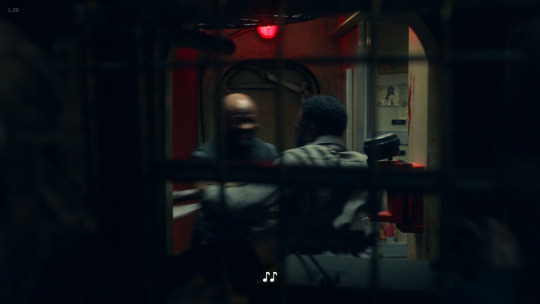
Morgan was thrown to a group of walkers who then surrounded and piled on top of him. That's pretty much with what we think happened with Beth except she was in the car and had that for protection.
And how did Morgan escape? They don't show us. We don't know. Very similar to when Rick got stuck in the RV in 6x03 and somehow miraculously escaped. I'm not saying all these instances are terribly realistic, but there’s a theme about being surrounded by walkers and that, for all intents and purposes, the character should have died, but somehow, they make it out alive.
So this is a very Beth-ish theme. In the episode, Dakota even says over the radio that Strand killed Morgan, which makes Grace cry. But then he shows up again. So, this is a very tiny death, fake out, and resurrection.

But there’s a more practical product of Strand’s actions here as well. Morgan manages to steal a bunch of key cards (yes, the “keys”) to the room Teddy is in. That would not have happened if Strand had not sacrificed Morgan and left him behind. They would have simply been locked outside the room and all 23 of the missiles would have been launched, more than likely resulting in some kind of nuclear winter. The ONLY reason they were able to prevent as much as they did is because Strand left Morgan behind.
See where I’m going with this? Much as with Beth, according to Father Gabriel was “sacrificed” and left behind, Morgan was, too. And he returned with the keys that saved everyone.
I really do think the same will be true Beth. It will be one of these things where only because she was left behind and knows what she knows about the CRM will team family have any hope of winning the war or surviving in the long term. That's the whole function of her arc of being left behind. It’s why we saw the keys at Grady in Coda. Because what happened there will be the key to saving everyone much farther down the line.
From a Christian symbolism perspective, let’s just appreciate that there were plenty of his followers who mourned him and thought him dead for good because they didn’t understand the resurrection angle. They were shocked when he suddenly stood before him again. Happy, but shocked.
That’s basically the effect tptb are trying to create here with both TF and the audience. That’s why all the misdirection and evasion. That’s why the death fake out. It’s a long game, but it’s really kind of genius.
Anyway, that’s why we saw this whole Strand/Morgan sequence in this episode. It’s a template for what happened with Beth.
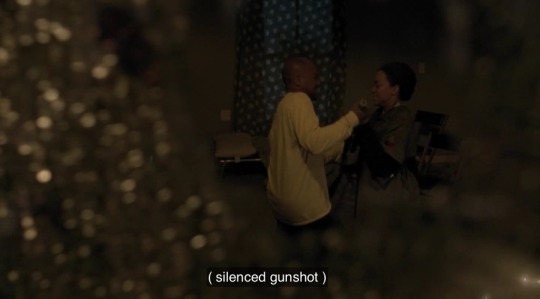
Every time we see something like this, it also puts me in mind of what happened with Sasha. We don’t know exactly what it is, yet, but Father Gabriel, in 5x16, accused her of sacrificing one of their own. You could take FG’s entire speech from that episode and apply it to this smaller situation with Morgan and Strand and it would work across the board. So, whatever happened during those missing 17 days, Sasha is in Strand’s position in the template and did something to “sacrifice” Beth.
But I digress…
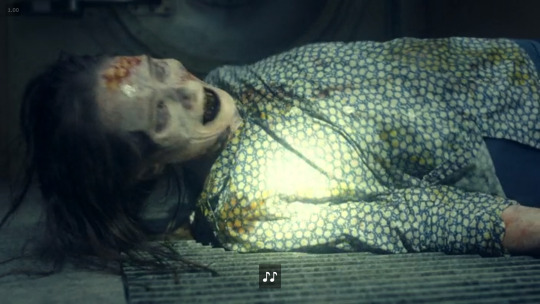
While standing in front of the door, Strand and Morgan also see a woman who looks like a civilian. Strand says she's probably one of Teddy's people because she's not wearing any kind of Navy uniform. She's wearing almost entirely blue with specs of yellow on her shirt.
The other symbol we saw a lot of here is walkers handcuffed to various places in the submarine. Some of them are handcuffed in their bunks. Others to the stations that were manning when they died. It reminds me of the random handcuffed Daryl found in S8.

In that case, there was no one in it, which suggests escape from captivity (*coughs Beth*). Here, the people are all still in handcuffs and they clearly died and became walkers. So, it's sort of a death while in captivity sort of theme. And I'm not sure how to relate it to Beth, exactly, except that it's an anti-parallel. But I'm absolutely certain it's intentional and we should take note of it.
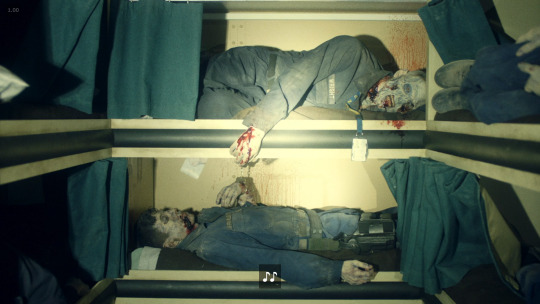
It took two keys, which is important (2 Theory) to launch the first missile.
Teddy says that one is enough to get them started, and he doesn’t say exactly where it's going or what places he’s targeted, but he says they will be hard to miss. I’m hoping they tell us what the targets were in 6x16 next week. Since they’re in Texas, the targets may play heavily into Texas and Eugene themes. But we’ll just have to wait and see.

Then Teddy literally says this of where the missiles might be going:
"Maybe toward the water—oh." He goes on to say more. The “oh” is a realization of something. But it caught my eye that we had the water mention and the “oh” in the same sentence.

Morgan basically lets John and Riley go. This is the only super unrealistic thing I noticed in this episode. Why would you let them go so they can continue their evil plan? But clearly their time in the story isn’t up and the writers need them to be around for whatever will happen next.
Two more symbols to take note of before I end.
Morgan's ax is broken. I really think this is probably a symbol of the world he’s been trying to create being over. Remember that he put the ax outside the community as a symbol of solidarity and peace. Now it's broken, which means that peace is broken. And no matter what happens, they will probably never have the community Grace saw in her dream. It doesn't surprise me because I figured at some point, the characters from Fear will cross back over to the main show or else to the spinoff. This is just a symbol that the wonderful, peaceful world that Morgan was trying to create pretty much ended when this missile was launched.
Going back to the beginning of the episode when it showed the wind blowing through the church doors and the defunct merry-go-round (which represents his and Grace's relationship), this is why the symbols are so potent. It foreshadows that all the good things that they built up so far are about to end.
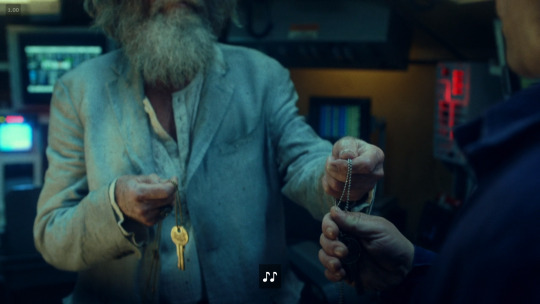
Finally, they started with 23 missiles in the submarine. They launched one. Which means there are 22 left. Check out @frangipanilove’s 22 theory for why that's so important.
How did everyone else like the episode? Did you see anything I missed?
#beth greene#beth greene lives#beth is alive#beth is coming#td theory#td theories#team delusional#team defiance#beth is almost here#bethyl
7 notes
·
View notes
Text
The Life and Times of Scrooge McDuck: The Buckaroo of the Badlands “It’s the Glory of Achievement that Counts”
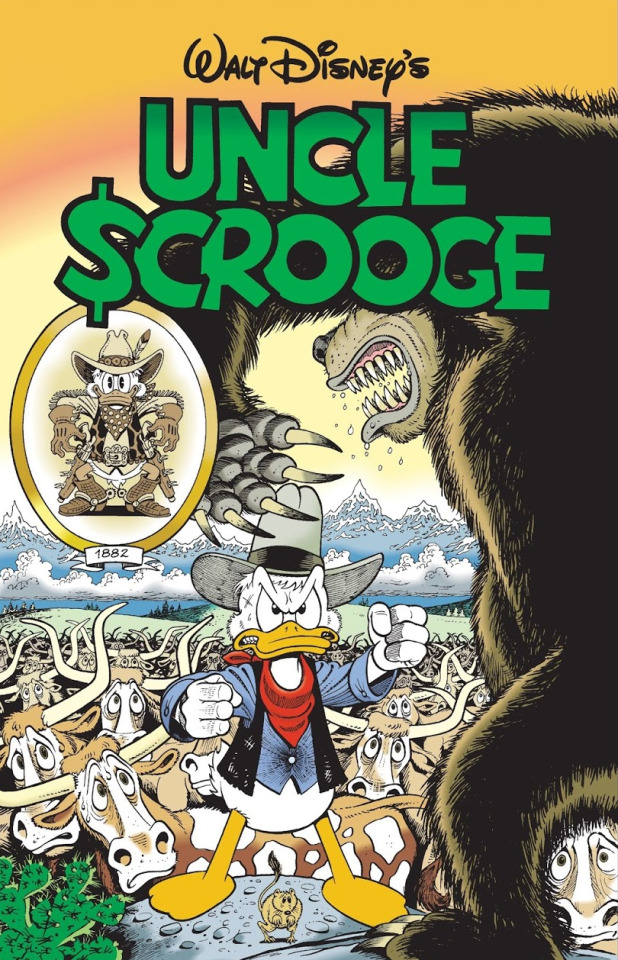
Hello you beautiful people and WELCOME BACK. It’s been a LONG time since I returned to this series hasn’t it? But I couldn’t put it off any longer especailly with a LOT of projects to do in February, so i’m pleased as punch to bring this series back for another round. And since like last time a lot of the behind the scene’s for this one can be dolled out as we go, join me under the cut as we get into some cowboy adventures with Srooge.. and President Teddy Rosevelt. Bully!

When we last left Scrooge almost a month ago, He’d decided, after bottoming out in riverboating, like many young men of his generation to Go West and seek his fortune and took up work on the Wabash Cannonball to do so.
So via letter we find out Scrooge eventually made enough money and has now afforded enough to take a train west, as a passenger. He’s also 15 at this point.. had to look that up because again, the comic dosen’t tell us the date.. and it’s you know been two months. He runs into a man selling square eggs who was SUPPOSED to be the professor from the Barks Story Lost in the Andes.. but he apparnelty died or something like that, and Barks was left to use another minor character in a way that didn’t make sense either it turned out and I don’t really feel like getting into. Point is the square eggs from that story make a cameo and Scrooge gets square egg all over his face after assuming the guy was just full of square chicken shit.
It’s then Scrooge runs into Jesse James, pre assasination by the coward robert ford, who shows up to the train to rob it.. but Scrooge tricks him when he and his crony take stock of Scrooge’s valuables, claming theirs jewels in the teeth of the golden dentures.. before slamming hard on them and giving the guy a bite and with their guns jammed and Scrooge prepared to beat them senseless, Jesse and goon wisely flee. Scrooge yells after them.. but the train speeds up to make distance between them and the bandits.. and accidenlty dumps Scrooge off, leaving him lost and alone in Montana.
Thankfully it dosen’t take him long before he runs into people, specifically a cattle drive and wants to join them as a rootin tootin cowboy. Turns out the Cattle Baron and head of the drive, Murdo Mckenzie a real life cattle baron, is a fellow Scot and a nice enough guy to take Scrooge on, especially because Scrooge, due to his time on the cattle boat to get to america, has cattle experince. He just needs to ride a horse and he’s set.. but Scrooge never has.. and is put on their roughest horse the windowmaker

Thankfully in a really funny sequence, Scrooge’s money belt is clipped, so he stays on and while he looses his other clothes. So Murdo hires the naked 15 year old on a horse....

Thankfully this isn’t nearly as horrifying as it sounds as Murdo makes him put his clothes back on first, and let’s him keep the horse as he needs him for a special job. Also Scrooge calls himself Buck McDuck because it’s more of a cowboy name and not everyone can pull of cowboying without one on their first day. What i’m saying is the creed i live by every day.. not everyone can be Droopy. All you can do is try to be that cool.
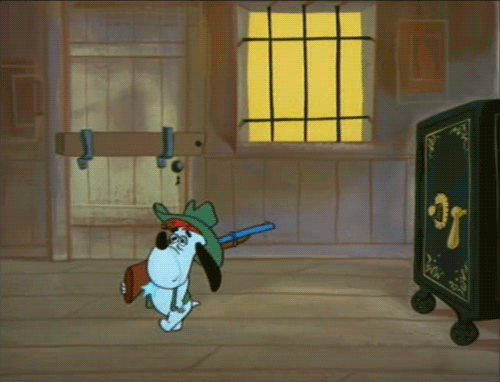
The job is to guard his prized angus steer he imported for a fortune from Scotland, which it’s current handlers the McViper brothers object to, though Murdo shrugs them off. Naturally with a name like McViper they were planning on stealing it. Seriously who hires someone with the name McViper unless your planning to try and murder batman with a nest of vipers or a viper shaped tank or a buzzsaw shaped to look like your dad who never loved you enough.
So we then get a time passing montage via a letter Scrooge wrote. Originally this was supposed to be the majority of the story.. but Rosa’s editor rightly pointed out that while showing Scrooge as inexpericed and still not quite to his full strength yet was fine.. Rosa overdid it with his gags and made him look like a moron. So the finished product wisely dialed it back to just the horse riding gag. Honeslty it was the right call as his excitment to be a cowboy and episodes with the horse show he’s still got a ways to go and is far from the duck we know now, while the earlier fight on the train shows he’s still plenty badass. he’s just not properly seasoned yet. It’s how he is for the first third of the story: an idealisic teen who is slowly learning the ways of the world and finding good reason to do what he does and learning his morals. It’s the middle part that breaks him into the man he is today and the last one is the early days of that man and the horrible mistakes that cost him quite a bit: his family, his love for adventuring and nearly his soul.
We get a few gags about crossing the planes and the reveal Donald renamed his horse after his sister hortense due to his horse’s bad temper. Hortense takes it as you’d expect.. by snapping off part of her mother’s chair with her bare beak in a rage and grumbling.

Scrooge is finishing up another letter by the time we cut back to him, the drive having almost reach the ranch in Montana... only for the McViper’s to conk scrogoe on the head and take the steer towards the Dakota territory and the real life Dakota Badlands, because now as ever Rosa loved to set his stories in cool real life locations. After Murdo finds him and wakes him up, and fully buys his story since the McViper’s were acting suspcious.. which is kinda like saying water is wet or Rudy Guliani is a moron but regardless buck mcduck rides again and eventually makes his way to the badlands. Which are awesomely rendered and really do look like that.

As you can see our hero finds someone in need.. and it’s Teddy Fucking Roosevelt!

As you can tell I love the guy. Really need to look into him more, but eveyr time I read his trope page or hear something about the man i’m in awe. He’s not without flaws, he was man of the 1800′s and 1900′s, he supported eugenics.. but he was also the first “accidental” President (I.e. a vp who got the role) to formally win despite being given the roll soley to keep him out of the chair due to being a boisterous loveable maniac, invited Booker T. Washington, who I also need to look into, to the white house as the first African American to get invited to dinner there, founded so many parks they had to make the national park service, and supported women’s rights his whole political career. The man is larger than life and respecte din fiction and I intend to make a story with him as a cybernetic frankenstein one day because i’m kinda nuts too and relate to him. He also has a quote I find endlessly relevant after the last 4 years of misery.
"This country has nothing to fear from the crooked man who fails. We put him in jail. It is the crooked man who succeeds who is a threat to this country."
So yeah on top of everything else.. he’s smarter than pretty much the entirety of the modern republican party on top of that, not a HIGH bar to clear mind you but still. He cleared it.
So naturally someone who was basically a real life Scrooge who, while not having earned his money, used it well and never stopped explorin, and also named his son Kermit for some reason, Rosa was not only a huge fan but couldn’t resisit putting him in the story as Scrooge’s mentor once he found out they were in the same area at the same time. He’s also the first one I feel changes him as a person.. his parents set down the foundation and Pothole was.. there I guess.. I mean he ran his first buiness thanks to him and had his first feelings that being rich isn’t an endgoal, But it’s Teddy who helps him realize one of his most important and lasting charactert traits: his love of adventure for the experince of it just as much as the prize.
And we quickly get to that as Scrooge, after running into a dinosaur skeleton and then letting Teddy free, takes him along with him and finds out Teddy is rich, college graduate and former poltician too, and is out here simply because cattle ranching is way more exciting. Scrooge questions this as .. why do this? He’s rich, he dosen’t need to and Scrooge honestly wishes he was born rich instead. But Teddy shoots that down: He missed being born poor like Scrooge.. because being born wealthy is no acomplishment. You just get handed money to do whatever... but earning it with your own hands, the experinces that lead there.. that’s the real treasure and that’s why he’ll never stop. And he sees that in Scrooge, pointing out someone who didn’t LOVE adventure.. wouldn’t of leaped at a dinosaur skeleton without a second thought, all to save someone he just met. It’s what makes Scrooge likable: Sure he’s a greedy dick.. but he’s one who will never be satisfied, and who only stopped when he was close to death accoridng to Rosa, and even then i’m sure his and Goldie’s retirment wasn’t ENTIRELY peaceful or event free. HIs love of adventure and finding new discoveries and new worlds and ones lost to time... that’s infectious and what makes his stories, and the character work so well. And Rosa has him discover it beautifully, realizing that he never would’ve been satisfied even with cushy family money and that he truly does like this.. he still wants to be rich and understandably so, but he can have some fun along the way and afterwords.
So truly changed by this Scrooge gets back to tracking and TR helps by... asking some local Native American Buffallo Hunters since he knows their expert trackers and while they haven’t seen the mcvipers they can SMELL them, and with a location , and his first apprication for other cultures, Scrooge and TR head up top to lasso em up... and while Scrooge grabs one.> TR grabs a bear and the insuing chaos, including Scrooge refusing to use up his bullets because “Do you know how much bullets cost”

So in short the mcvipers end up chased by the bear, the native americans end up chased by a buffalo with a skull on it’s head and Scrooge ends up on the Angus. Teddy sums it up best.

It’s a great comedic set piece.. and leads to Murdo arriving and our heroes emerging, with the angus and tow and victorious. For his help and bravery, Scrooge is awarded the job as manager of the land, and while he plans to leave in a few years to find his fortune, it’s a good steady job he can help his family with and learn some skills so why not. TR leaves him with some last words of ecnouragment and says “There’s the makings of a great man” as he rides off into the susnset.. and his clothes once agian head the other way.
Final Thoughts:
Buckaroo of the Badlands is a solid chapter. After the overly long Master of the Missippi, this is a welcome return to form, with a hell of a guest star, an intresting setting and some fun slapstick. It also reminded me not EVERY chapter is super long, as most are only 13 pages but Rosa packs a LOT into them, and uses each one wisely. Overall an excellent return to the series and I hope to pick it up eveyr now and again between whatever I have scheduled for the day.. and to look into Teddy. Seriously what a man, what a man what a mighty good man. Next Time Scrooge meets another mentor, a future foe, and the lonliness of being rich Teddy warns him about here in “Raider of the Copper Hill” Until the next Rainbow, it’s been a pleasure.
#the life and times of scrooge mcduck#scrooge mcduck#buckaroo of the badlands#hortense mcduck#teddy roosevelt#western#cowboy#montana#don rosa#disney#disney comics
20 notes
·
View notes
Text
The one(s) who never stop searching
I sometimes wonder whether Hanguang Jun grew up with a role model, is there anyone he looks up to, or that just doesn’t exist because LWJ is too busy being admired and respected by pretty much everyone else (apart from his biggest anti-fan Su She).
Of course, he adores his soulmate. BUT, now rewatching the Coffin Town arc, I just really want to write something about LWJ and his admiration for Xiao Xingchen/Song Lan.

LWJ first met XXC and SL in episode 10 when checking out Chang clan’s manor in Yue Yang with WWX and JC. The duo captured Xue Yang there, and introduced themselves to the gang.
‘Xiao Xingchen, the moon in the breeze. Song Zichen, the Gentry despite the frost. Your decency is known to us’. This was probably the longest sentence LWJ said to another human being since the beginning of the series. Even his eyes scream ‘I’m a fan’ and makes WWX turn around in surprise.
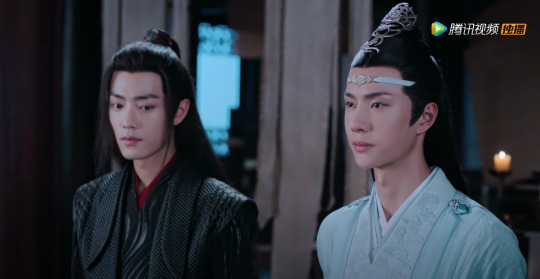
During their later conversation as NHS and JGY arrive, XXC and SL talk about how they’re not interested in bloodlines and just cherish those with same ambitions. LWJ has obviously been listening very carefully, and even actually asks where they cultivate and how others can find them. I mean, since LWJ has not really opened up by that point, it’s truly impressive coming across new characters that manage to generate so much interest from LWJ within a very short time. Let me repeat. he even ASKS PERSONAL QUESTIONS!


His admiration becomes VERY clear just a few minutes after during the farewell scene. It’s probably only the 3rd time LWJ gives us a mellow facial expression since episode 1. He watches on as XXC and SL depart - quite a long look with a mix of emotions: appreciating, pondering, wondering, with a tiny bit of sorrow, somehow. He was clearly in his own world until WWX calls him back down to earth. He then gives his soulmate a soft look before nodding and following the gang. WWX clearly senses that LWJ has something in mind, as they walk, he turns and looks at LWJ.
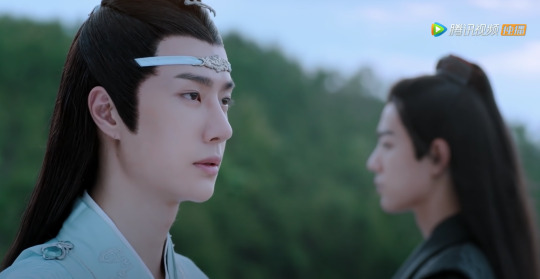
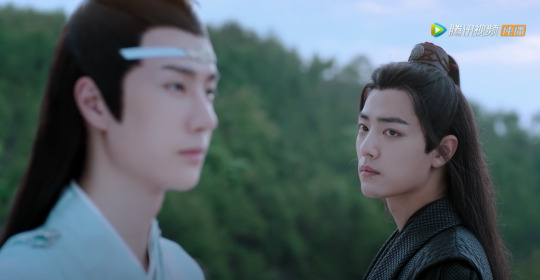
This is how I interpret LWJ’s thought process in that sequence. As he looks on XXC and SL leaving, it feels like he has a bunch of ‘What if...’ questions in his head. Probably something along the line of ‘Darn, wouldn’t it be nice to just roam the world with your lifelong confidant, protect the weak, exorcise the evil without the burden of playing clan politics? What if I was not restricted by 3,500 rules at Gusu? What if I could actually live a life as in my name WangJi - to not seek fame or wealth, forget about worldly matters, and be at peace with the world?’. As soon as WWX calls him he turns around and.... ‘What if I could live that life with this person?’.
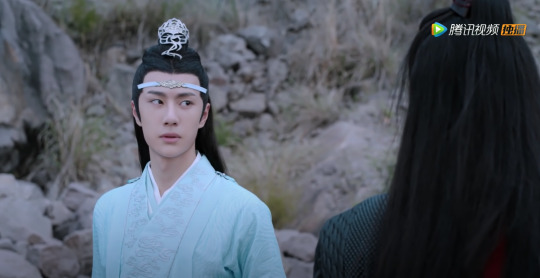
I’m convinced from this point, LWJ already has a vision in his head about going on adventures with his soulmate. We know he eventually got his dream come true from episode 34 onward, but it was a very very long and painful way for him to get there. At the end of episode 35, when filling WWX in about what happened to XXC and SL, LWJ was visibly upset which led him into having himself a drink. Some may argue that his frustration is due to people still shitting on WWX after all these years, or about the injustice related to Jin clan and Xue Yang rather than XXC and SL. I still think that being reminded of the duo’s tragic fate when talking to WWX does have some impact on LWJ’s emotion.
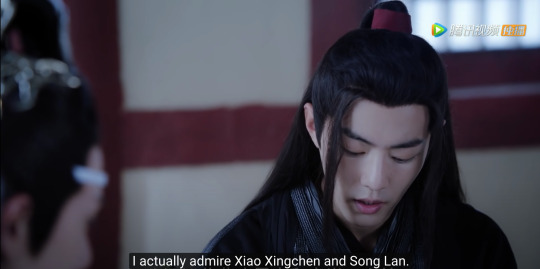
It was a clear case of extreme clan-related injustice that brought so much pain to the lives of 2 people who are not even attached to any sect whatsoever, 2 people who just purely wanted to protect the world from evil while not taking side. They were simply caught up in the whole major clans corruption shamble, and clearly the last people on earth who deserved to die/gone missing because of the clans’ mess. For someone who has long admired their decency, how would that NOT frustrate LWJ - someone who’s already in a long battle against injustice that screwed over his soulmate’s life?

Fast forward to the end of the Coffin Town arc in episode 39, it’s now revealed that Xue Yang murdered everyone at Snow White Pavilion, turned SL blind and led XXC to give his eyes to SL. As LWJ was searching for WWX, elsewhere, someone else was also looking for their other half. Unfortunately, SL arrived to find XXC being deceived by Xue Yang, and basically all of them ended up with tragic fates. Once all of the misunderstanding is finally clarified, we find WangXian and the junior disciples in front of A Qing’s grave. Once again, WWX notices LWJ being miles away in his own thoughts. He looks up and stares into his soulmate’s beautifully surreal face. It has an odd sense of relief in his vision, mixed with a bit of fear - a ‘close call’ type of fear, like... ‘Something even more awful could have happened’.


LWJ then mumbles ‘Fortunately...’ to a confused WWX and probably because of censorship, we never get to hear the end of that sentence. Putting in the context of everything that just happened to them, it’s not too difficult to work out that LWJ was acknowledging how extremely lucky he was being able to reunite with WWX safe and sound. Sadly, XXC and SL did not get that chance.
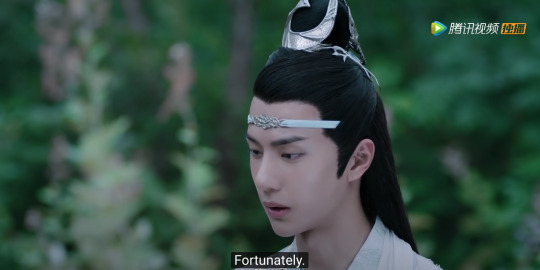
They then returned to XXC’s coffin to find SL. LWJ looks on, apologetically, as WWX gives SL what’s left of XXC’s spiritual cognition. Just a quick side note, I cry EVERY SINGLE TIME watching SL write in the soil with this sword ‘Roam this world with Frostwork. Exorcise evil beings alongside Xingchen’.
LWJ then looks up to SL and it feels so strongly that he wanted to say something. He’s been there - he saw his soulmate falling off the cliff. He started to invest most of his time searching for WWX, from appearing whenever chaos was to communicating with spirits asking for WWX’s whereabouts. 16 years of mourning the dead and living with the pain, feeling incomplete and empty without his counterpart.
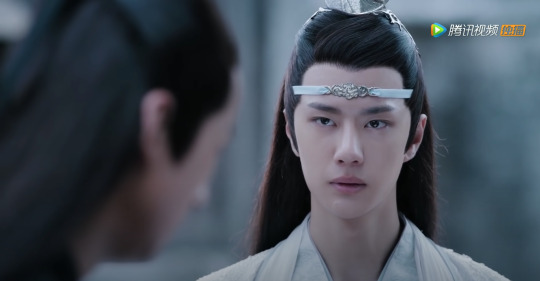
LWJ is the only person who can relate to SL. And that’s probably why he knows there’s nothing to be said that could ease the pain. He proceeds to respectfully present SL with XXC’s Frostwork and bow.
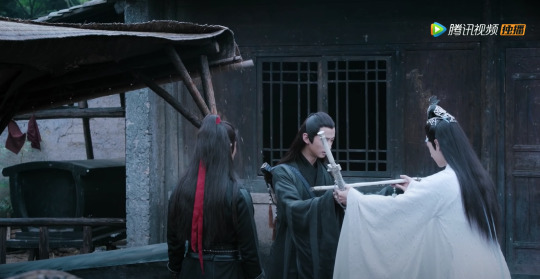
LWJ, with sadness in his eyes, watches SL walk away, this time without XXC by his side. The scene cuts to WWX thinking to himself ‘I wonder if the two of them would be able to meet each other again’. The same thought must have gone through LWJ’s mind as well. WangXian then exchange a mournful look - if only the camera has stuck around longer for us right here, as I’m sure, this could have been the ‘We should be thankful that we are still standing in front of each other’.
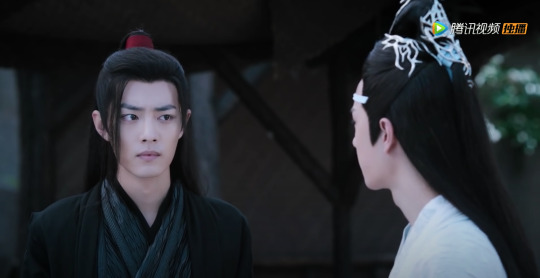
I really appreciate The Untamed crew setting a good 3-episode arc aside to tell the tragic story of XXC/SL/XY the best way they could. It’s also a good idea to change the timeline of certain event so that XXC and SL cross path with WangXian in WWX’s first life, as it lets us see from very early on that LWJ is not just a rigid guy to follow rules all the time. He doesn’t have all the answers to everything in his life just because he reads all the books at Gusu. He does have certain insecurity and curiosity about a different path, now that there’s someone in his life that make it worth considering. It also provides more context to the unfortunate contrary between the fates of WangXian and SongXiao.
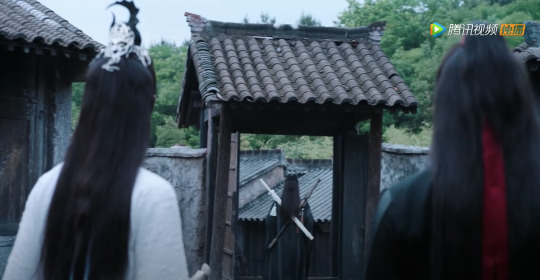
If you’re also impressed with this arc as much as I am, I would strongly recommend checking out the novel as it tells us a lot more about SongXiao origin story and how their feud with Xue Yang started. Besides the main couple whom all of us obviously stan, this storyline definitely impressed me the most rather than anything else. I really wish one day Song Lan would succeed in nursing Xiao Xingchen’s spiritual recognition back to wholeness and they would meet again.
#xiao xingchen#song lan#xue yang#wei wuxian#wei ying#yiling laozu#lan zhan#lan wangji#hanguang jun#the untamed#chen qing ling#mo dao zu shi#thoughts
331 notes
·
View notes
Text
The Leithian Reread - Canto VI (Beren in Nargothrond)
While The Leithian-related plot of this canto focuses on Beren in Nargothrond, almost the first half of it is a brief summary of the Silmarillion from Return of the Noldor through to the Dagor Bragollach. Which I love, since those events for the most part aren’t coverered in Tolkien’s other poetic works, and I prefer the poetry structure of the Leithian to Tolkien’s other (non-rhyming, more Rohirric-sounding) pieces of epic poetry.
This is a good place to note, for readers who are new to the poetic Leithian, that some names are different from the Silm (Tolkien started a revised version with Silm-consistent names, but he didn’t get very far with it). The Noldor are referred to as the Gnomes - a rough transliteration of their elvish name into a human language, drawing from the Greek for ‘knowledge’. Tolkien later rejected this on the basis that the word was already too associated with entirely different mental images, but given how transformative his use of ‘elves’ was (typical fantasy elves are now almost all inspired by his ideas of tall, beautiful, long-lived immortals), we might have completely different concepts of ‘gnome’ now if he’s gone ahead with it.
The second big diiference is that Finrod is referred to exclusively as Felagund - his Dwarven honorific - whereas his father Finarfin is referred to as Finrod. Tolkien had a lot of difficulty with Finarfin’s name and it went through a pile of different iterations. There are also other minor differences, like Finwë being referred to as Finn.
Returning to the poem - it’s hard to pick a favourite part of the summary section; I love so much of it. This is the closest I’m ever going to get to the Noldolantë (Tolkien wrote a couple pages of another poem focusing on the Return of the Noldor, but I don’t like it as much).
The mists were mantled round the towers
of the Elves’ white city by the sea.
There countless torches fitfully
did start and twinkle, as the Gnomes
were gathered to their fading homes
and thronged the wide and winding stair
that led to the wide echoing square.
There Fëanor mourned his jewels divine,
the Silmarils he made. Like wine
his wild and potent words them fill;
a great host hearkens deathly still.
But all he said both wild and wise
half truth and half the fruit of lies
that Morgoth sowed in Valinor
in other songs and other lore
recorded is.
There’s such a wonderful sense of place and of mood in those lines; the Return of the Noldor has always been one of the most compelling parts of the Silmarillion for me. In the same way that Elves have a different sense of time than Men, Valar must have a different sense of it than Elves; they’re acting, but within their own sense of time, and for the Noldor, in the wake of the Darkening, the desire to do something rather than wait around for the Valar (who are looking more deeply fallible than they ever have before) to fix things must be extremely powerful. And Fëanor’s presence and words and fury, brought into that environment, is like fire to oil. To be active and purposeful in the face of disaster, rather than passive and directionless - that’s a powerful force. The poem also acknowledges that Fëanor’s not entirely wrong (“half truth and half the fruit of lies”), however deeply distorted his ideas about both the Valar and the Secondborn are. As I’ve said before, I think that Eru intended for the Elves to be in Middle-earth, not Valinor; the entire Leithian is centred around the value and importance of an elf-human relationship that continues to affect the history of Arda down through the Third Age (and, in its symbolic meaning, even further).
There’s also a line about the Oath: Who calls these names in witness may not break his oath, though earth and heaven shake. The texts on the Oath are somewhat contradictory on its breakability, though they are united on its importance and severity (it is decidedly not just words, or something that can be casually laid aside). The Silmarillion says “so sworn, good or evil, an oath may not be broken, and it shall pursue oathkeeper and oathbreaker to the world’s end”. But that contradicts itself - it it can’t be broken, then there can’t be oathbreakers. Maedhros and Maglor’s final conversation at the end of the Silm is more illuminating to me: it’s not a matter of the Oath being physically or psychologically impossible to break (if it was, how did they go the 400 years of the Siege of Angband without actively attacking Morgoth?), but of fearing the fate they have called down upon themselves (the Everlasting Darkness) if they do break it. (Plus a lot of sunk cost fallacy, by that point.) Which is considerably less sympathetic: murdering innocent people in order to avoid the consequences of your own bad decision is, ultimately, the choice that innocents should bear the cost of your own choices, which is ultimately a form of cowardice. (Not to mention the inherently contradictory nature of saying “I’m going to do evil so that I won’t be damned,” which Maglor eventually realizes.)
(More of my thoughts on the Oath here.)
This is also one of the few texts we have that actually states the Oath (or rather, part of it; the invocations are not included) rather that describing it. I think all the ones we have are in Tolkien’s poetry; there’s no prose version.
The Kinslaying is not mentioned in this Canto; that’s saved for the Duel of Felagund and Sauron in the next one. But this canto does include possibly the only poetic rendition we get of Fingon rescuing Maedhros from Thangorodrim:
Fingon daring alone went forth
and sought for Maidros where he hung;
in torment terrible he swung,
his wrist in band of forgéd steel,
from a sheer precipice where reel
the dizzy senses staring down
from Thangorodrim’s stony crown.
The song of Fingon Elves yet sing,
captain of armies, Gnomish king...
They sing how Maidros free he set,
and stayed the feud that slumbered yet
between the children proud of Finn.
After describing the Siege of Angband and the Long Peace, the narrative moves on to the Dagor Bragollach, and specifically Barahir’s rescue of Felagund. (And in this account, as in the Silm, Orodreth is Felagund’s brother, not his nephew.) From there, it returns to the main story and Beren’s arrival in Nargothrond. It could not be more different than his reception in Menegroth:
When the ring [of Barahir] was seen
they bowed before him, though his plight
was poor and beggarly...
Fair were the words of Narog’s king
to Beren, and his wandering
and all his feuds and bitter wars
recounted soon.
Regarding Felagund’s fulfillment of his Oath to Barahir, and the betrayal by Celegorm and Curufin, and the abandonment by the Elves of Nargothrond, I’ve already written a fair bit in my (much earlier) posts on Finrod & Nargothrond and Celegorm & Curufin. I’ll add a few additional points here.
First, I do not think it was irresponsible of Felagund to leave Nargothrond to go with Beren. If his presence as king of Nargothrond was important (and I think it was; basically all of Nargothrond’s decisions after he leaves are bad, and he’s been the peacemaker and diplomat between different elven and human groups throughout the Silmarillion up to this point) that is all the more reason why Nargothrond is indebted to Barahir and his descendents, since Felagund would already be dead if not for Barahir’s actions.
Secondly - and I’m getting this from Philosopher at Large’s Leithian Script, which emphasizes it very heavily - Felagund, as liege-lord to the Bëorings, has certain obligations to them even outside of his oath, including providing military assistance in times of need. Usual chains of communication have been cut since the Bragollach, so Felagund’s only just now finding out that the Bëorings have, aside from Beren, been basically exterminated; and that Barahir and later Beren spent years fighting a very long-odds guerrilla war without ever asking or recieving assistance, while Nargothrond was safe and largely inactive. This is going to strongly enhance Felagund’s (legitimate) sense of indebtedness to Barahir’s kin.
Thirdly, Celegorm is often treated as something of a meathead (because he acts like one; all his decisions are terrible in both moral and practical terms), but this sequence makes it clear that both he and Curufin inherited their father’s rhetorical abilities; his speech is specifically compared to Fëanor’s speech in Tirion (Many wild and potent words he spoke, and as before in Tûn awoke his father’s voice their hearts to fire, so now dark fear and brooding ire he cast on them...) But ironically, the direction of Curufin’s speech is opposite to Fëanor’s - while Fëanor’s was about rallying the Noldor to fight Morgoth, Curufin’s is about discouraging them from fighting Morgoth, by frightening them, and he does it so effectively that it’s unlikely Nargothrond would have showed up at the Nirnaeth Arnoediad even without the additional motivation of being furious at the brothers. And continuing on that theme, the brothers are setting themselves against the first real attempt anyone has ever made to regain the Silmarils from Morgoth. A mission that resulted in Beren and Lúthien having one Silmaril, and the Fëanorians having the other two, would obviously be better in terms of their goals than all three remaining in Morgoth’s posession, but they don’t appear to even consider it. This is part of a long thread throughout the Silmarillion - every action taken directly in service to the Oath aids Morgoth and harms the Eldar.
The people of Nargothrond, by the way, really do not come off well here - they’re rejecting their king for someone who has just threatened violence against them all (Celegorm’s speech is basically threatening them with another Kinslaying here and now).
And as a final point - what Celegorm and Curufin do here is one of the worst crimes imaginable within their society. The sacredness of the relationship between guests and hosts (and they are guests in Nargothrond, having fled there from the Bragollach) is a major theme in a lot of pre-modern societies. People familiar with A Song of Ice and Fire will remember its importance there; for a more historical source, Dante places ‘traitors to guests and hosts’ in the ninth circle of hell in the Divine Comedy and goes beyond that to state that people who betray their guests or hosts go directly to hell even before they die, while their body becomes inhabited by a demon for the rest of their life. From this betrayal, to the usurpation of Nargothrond, to the attempted rape of Lúthien, to the attempted murder of Lúthien, to Celegorm’s servants leaving Eluréd and Elurín - young children - to die of exposure, everything we see from the brothers from this point on is them committing crimes that are literally unthinkable to elves. Which is to say that the Eldar might have found Dante’s explanation pretty credible.
#tolkien#the silmarillion#fëanor#sons of fëanor#beren#finrod#celegorm#curufin#nargothrond#oath of feanor#lay of leithian#leithian reread
41 notes
·
View notes
Text
Chihayafuru | Why read it?
This is a comprehensive, non-spoilers review I made of the series on Goodreads recently, and I thought I would leave it here for potential readers as well. As the series will come to a close within the next year or two, there’s no better time to pick up Chihayafuru than now. The following review covers: a basic summary of the series, a brief explanation of karuta, highlighted aspects of the narrative, and common misconceptions. Enjoy!
Chihayafuru primarily follows three childhood friends—Chihaya, Arata, and Taichi—and their journey through karuta, a Japanese sport inspired by one hundred classical poems found in the famed Hyakunin Isshu. The trio bonds over karuta as children before they're inevitably separated due to a number of circumstances, until their paths cross once again in high school. Their efforts to rise to the top of the sport's hierarchy in Japan parallel to their personal relationships with each other, as well as their insecurities, hopes, and fears for the future as they grow up.
REP: visually disabled SC.
TW’s: verbal parental abuse.
Karuta (or more specifically, kyogi karuta) is a Japanese card game. The poems of the Hyakunin Isshu are transcribed onto two sets of one hundred cards each—the yomifuda, or reading cards, have a full poem transcribed onto them, while the torifuda, or grabbing cards, have only the second half of a poem transcribed onto them. Each player has a territory with twenty five cards, and the object of the game is to grab the correct torifuda as soon as the corresponding yomifuda is read. There are also a few more complex rules, but ultimately, whoever clears all of the cards in their territory first wins. Karuta is a game that tests memorization, agility, hearing ability, strategy, stamina, etc.
The following are aspects of the series that I think really make it stand out!
The expansive cast. Karuta is an all-ages competitive sport. People from all walks of life compete against each other, so there's a broad range of characters introduced across the course of the series: old doctors, married women, high school teachers, elementary students. It makes the personal experiences and learning points of the various characters all the richer. The appearances of background characters are also consistently recurring, which makes the fact that the cast is so expansive even more enjoyable, because no one is truly forgotten or cast aside.
The emphasis on teachers. An experience Chihayafuru especially explores in depth is that of teachers, both literal and figurative. They are constantly brought into focus: as competitors capable of displaying as much persistence as their juniors, as mentors who do their best to nurture the younger generation, and as people of a past era fighting to hold onto what grasp of the present that they have left. Their insight is invaluable to the younger characters that the series primarily focuses on, and they can hardly be called backseat players.
The exploration into parent-child dynamics. Although the angle from which Chihayafuru explores parents and their influence on their children is a little different, it's also a just as valuable portrayed experience that I adore. There are parents who give their everything for their children, parents who don’t understand their children’s ambitions but support them as best they can, parents who demean those ambitions and create everlasting insecurities, parents who use their children’s ambitions for their own gain, etc. I think in that sense, there’s at least one parent-child dynamic that every reader could potentially relate to and find catharsis in reading about as these relationships grow and change.
The series' refusal to treat karuta as insular. A lot of sports manga have a tendency to focus almost exclusively on the sport in question, with no thought given to the characters' real-life problems, their families, or their future after high school. Chihayafuru, rather than making karuta the object of its story, instead makes it the narrative medium by which the characters' life stories are told. It's a series about people and their problems more than it is a series about the sport, which is what best sets it apart. The characters are constantly faced with the reality that they will have to confront their future and the need for a career at some point, because karuta isn’t a sport that pays nor one necessarily super-famous in Japan.
The use of poetry to parallel the events of the narrative. On the surface, karuta is just another card game; but what makes Chihayafuru special is that the poems being read at different parts of the story actually further contextualize what is happening. Although the course of the story can be understood without looking up what each mentioned poem means, there’s no denying that looking up the meanings adds so much more to the experience. It's one of the best Easter eggs the series has to offer, and it also lends further understanding to why players must cherish the cards for what they mean in order to truly love the sport. (Also, if you are into classical poetry and/or the use of nature-associated metaphors to illustrate life, this will definitely appeal to you!)
The analysis of the human psyche. There are several types of relationships and personal problems Chihayafuru explores. In particular, the friendship between Chihaya, Arata, and Taichi is complex. Their love triangle is deeply entrenched within each of their individual relationships with karuta and their individual insecurities, which is what makes it stand out to me as one of the best of its kind. Each of these characters undergoes expansive development as an individual, and yet the three of them are also inextricable of each other in terms of that development and their goals. There’s extensive exploration into what it means to truly love a sport, whether natural talent or hard work is more valuable, how ambition and success achieved at the cost of loneliness is to our own detriment, and whether the expectations of an older generation will define all that we are capable of becoming.
The exploration of playing as an individual versus as a team member. Karuta is a sport that can be played in teams (up through the end of grade school) or individually. Both aspects of play offer different insight into the nature of sports in general, about the characters' personal goals or desires, and about their complex relationships with the support systems that surround them, or lack thereof. There’s a huge emphasis put on the fact that ultimately, while experiences garnered while playing alone are valuable, karuta cannot exist on the backs of isolated individuals alone. Human camaraderie is necessary in order for the sport to thrive. One of my favorite quotes from the series is regarding this complex theme: Team matches are solo matches. Solo matches are team matches.
The women! Among its equally (or more) famous peers, Chihayafuru is perhaps the series that emphasizes on uplifting of women and women's friendships the most (an advantage lent to it by the all-ages, all-genders nature of the sport). There's a vast cast of female characters, and Chihaya and Shinobu in particular are protagonists whose strength is never undermined by the fact of them being women or the object of someone's affections. The women of the series are strong, air-headed, determined, lazy, ambitious, lost. There’s a vast array of experiences illustrated by them, and they’re allowed to embrace their womanhood while also refusing to be limited by it.
Here are some misconceptions about the series that I have seen encountered by both dedicated and casual readers (or viewers):
It's a series with little emotional payoff. As I mentioned before, Chihayafuru is most prominently a series about people and their problems. The personal journeys the characters undergo span hundreds of chapters. I've noticed before that some people give up on the series as a result, because their favorite character isn't where they want them to be within whatever span of chapters, but I want to encourage potential readers to not give into this inclination! This is a series where you need to be in it for the long haul, because the emphasis is that these emotional problems characters face are not ones that they can solve within the span of a few months. Sometimes, they take years (aside from the first volume covering a flashback sequence, the main narrative takes place over the course of three years).
Perception of the love triangle. A lot of people tend to zero in on the love triangle and make it their focus of reading, and especially for readers who attach themselves to Taichi, this often leads to disappointment in where the narrative leads (as he is a character who struggles immensely on his journey towards growth and self fulfillment). It's important to remember that each member of the childhood trio is their own individual! Issues tied to the love triangle are certainly important, but readers often miss out on crucial emotional development for characters because they're too focused on who they think Chihaya should end up with, when that's not even remotely the point. The narrative almost always emphasizes that at the heart of it all, Chihaya, Arata, and Taichi will always have each other. What matters more than the outcome of the love triangle is whether their friendship will ultimately heal and thrive, and whether they will grow as individuals who can support each other rather than act like crutches for each other.
This is not a series about sports! This may be a confusing thing to say, and it may not even be something that other Chihayafuru fans would agree with me on. But again, I'll reiterate: Chihayafuru is most prominently a series about people and their problems. Some matches can span several chapters, while others barely last a few panels. The focus is not so much on the sport as it is on what the sport or match is doing emotionally for the individual. In that sense, it's a bit different from its contemporaries, where almost every important match is covered in detail, from one move to the next. Although there are plenty of moments where karuta matches are covered in detail, don’t be surprised if there are moments where they proceed too fast, and think to yourself why showing the whole match may not have been necessary!
These are the main points that I could come up with, but if you have any questions, feel free to send me an ask on my blog. I hope any part of this can convince you to read Chihayafuru, as it’s a wonderful story that offers a lot of layers to dissect to its audience. There’s always something new to discover with it, and that’s what makes it special.
#chihayafuru#ayase chihaya#mashima taichi#wataya arata#wakamiya shinobu#meta#i'm just tagging them all so it gets spread gjfkgjfkdhl#but uhhh. i hope this is comprehensive#also if you disagree with anything pls send me an ask!#rather than reblog onto it with an essay or something gjfkjhlgdf#since this is a recommendation post i want to keep it clean#and as accessible to others as possible
40 notes
·
View notes
Text
i was finally able to see the bad star war that everyone said was bad. as it turns out, it was bad. here’s a read more post with my thoughts on it so that i don’t spam my twitter with spoiler tweets
for a baseline: i like the original trilogy, but i don’t think any of those movies are perfect. i think the prequels had some good ideas but i were mostly terrible. i love the clone wars (both versions) and rebels. while i admit that tfa was extremely similar to a new hope, i thought it was executed great and had a wonderful new cast that showed a ton of promise. i liked rogue one, although i found its first act really sloppy. and i have some quibbles about tlj, but it had an incredibly strong vision and actual themes, and i’d consider it my favorite in the series
i’m exactly the kind of person who was always going to hate the rise of skywalker, because it’s basically a bad fanfic written by someone who didn’t like tlj and wanted to “fix” the story. like that bizarre story treatment jenny nicholson read for this movie. the bad one. it was like that
it wasn’t all bad i guess. here are the small things i liked:
some of the new environments were cool. there was cool imagery and practical effects work
i appreciated that the moon of endor where the death star wreckage was wasn’t just the one with the ewoks, and thought the vibe there was cool
zorii bliss’s armor was really cool
the image of the fleet of star destroyers all lined up was striking
i liked that the ghost showed up for the final battle
i liked that ahsoka was one of the jedi voices rey heard, even though that kind of implies that ahsoka is, uh... dead?
while extremely fucking trite and dumb, i’ll admit the closing scene on tatooine got me. yeah, rey has no real connection to this place and it’s just a nostalgic throwback, but i’m a sucker for full circle endings like that
uh. that’s about it
this movie kicks off in the middle of an action scene and just kind of keeps jumping to new setpieces nonstop until it’s over. new characters and locations get introduced and then moved past in the blink of an eye. there’s no time to let any of it sink in. it feels like abrams crammed two movies worth of shit into this one to make up for the the fact that some people didn’t like tlj, and as a result none of it resonates. i just felt so empty throughout most of the film. events were happening on screen and none of it mattered
thoughts about individual elements:
LEIA
putting the scenes with the recycled footage of carrie fisher at the beginning of the film completely took me out of it. it was so obvious that she wasn’t really responding to what was being said, and the conversations had just been built around the limited leia lines they could use
the dialogue scenes with leia felt like a space ghost interview
C-3PO
was in this movie a lot for some reason? i guess abrams wanted to make up for how little c-3po there was in the last two movies. they tried to have that emotional moment where his memory is wiped, but then they just turned his memory loss into a big joke?? and then he got most of his memories back anyway
in general, the movie is afraid to let the audience be uncomfortable for long. 3po’s memory loss. the supposed deaths of chewbacca and babu frik, that sort of thing. you’re not allowed to be sad. after tlj so effectively built tension throughout the film and really pushed the heroes to the brink, this is a disappointment
LANDO
is here because he needed to show up, and because it’s a throwback to have him pilot the falcon again. he’s just kind of there with little to do and no arc
FINN, POE, AND ROSE
before the movie came out, i had low expectations. all i really wanted was to get one last fun adventure with the new characters. when i started to hear about the spoilers, my expectations sank even lower. but maybe i would still get this
nah! rose gets like two minutes of screentime because redditors hated her, and finn and poe are barely even characters. they don’t have arcs in this film, they’re just sidekicks on rey’s journey
finn really hurts. prior to tfa’s release, finn was framed as the new star. this was, of course, a bait and switch, as rey was really the new jedi. (finn apparently IS force sensitive according to this one, but hey! we can only have one big jedi hero, so like leia before him, i guess we’ve gotta wait for some EU novel to give finn a lightsaber)
but finn was still a central character in the last two films, and he had so much potential. he was a stormtrooper who defected! that’s something new! that’s interesting! it complicates the black and white morality of the series. but no. that’s been all but abandoned at this point
many have complained about how tfa establishes that basically all the stormtroopers are people who were kidnapped as children and brainwashed by the first order... but then they still have no qualms about gleefully killing them. in the first two movies i was like “yeah, it sucks that they have to kill those guys, but if it’s to prevent genocide, it’s understandable. that’s just war. maybe they’ll touch on it in the last movie.” so in this one, they kept reminding the audience that the stormtroopers were enslaved as children. jannah is even introduced as another stormtrooper who defected like finn. but then... it goes nowhere. finn doesn’t get any first order troops to defect. they don’t care about the other stormtroopers. how many hundreds of thousands of enslaved soldiers did they kill when they blew up those star destroyers
it was nice to see finn and poe take the charge as leaders in the end, but it also feels like they didn’t take the lessons from tlj to heart. the whole point of that story was that one-in-a-million shot heroic suicide missions aren’t worth it, and that they’re more useful to the resistance alive than they are as martyrs. but then in the climax of this film they take like 30 ships to go fight a fleet of a hundred fucking star destroyers
on the subject of that final battle: i thought that the ending of tlj was so powerful. the resistance was decimated, but they still had hope, because they knew there were others out there who could help. people like rey, or the broom boy, who came from nothing but had good hearts. in this one, though, they say that apparently nobody responded to the leia’s call for help in the entire year since the last film. everyone only shows up during the climax after lando’s like “no, but for real guys, we need help”
and i did think that that sequence was cool. and i did like seeing the ghost among the ships. it was fun. the message that fascists like the first order rule by making people feel isolated, and that they’re defeated by realizing that good people are never alone? that was good. i thought that was a strong message. but it’s such a minor footnote on a movie that’s so bad in so many other ways
oh and they made the latino dude a drug dealer. okay. thanks for that
KYLO REN
i hate that they redeemed kylo and i hate the way they did it
yes, him being coerced to turn to the dark side by snoke (who was apparently just a puppet controlled by palpatine all along (UGH)) as a kid was tragic. but that doesn’t excuse his actions. kylo was given infinite second chances throughout the trilogy, and every time he responded with violence. he killed so many people himself, and willingly took part in a fascist regime that killed billions. yes, his story is sad, but he’s not some poor little boy, he’s thirty fucking years old and he vents his trauma by slaughtering innocent people
literally the entire main trio of the original trilogy died because of this asshole. han tried to talk to him in the first movie, and got stabbed and dropped into a pit. luke died astral projecting to face him in tlj. and now leia just kind of arbitrarily died to flip the switch in his brain from bad to good from across the galaxy. it’s literally as simple as that. he doesn’t have a personal journey here. he just stops being evil because his mom made him through the force
like, again. all those enslaved stormtrooper grunts who had been brainwashed since they were kids? gunned down. but giving kylo endless second chances is the most important thing in the world
and then they end the movie by having this creepy abusive stalker genocidal asshole sadboy kiss rey, retroactively framing their dynamic as a romantic one. just, gross as hell. even in this one, for most of the film, all he does is threaten rey and boss her around
i dunno. i thought the first order were interesting as antagonists. yeah, they were just the empire 2.0. but i thought it was appropriate! the idea was that just because palpatine was dead and gone didn’t mean that fascism was gone. there were still hateful people who wanted to rule the galaxy via genocide. like how we still have nazis in the 21st century. except, oops! palpatine was actually alive and pulling the strings the entire time, so now that theme’s out the window. we just have to kill him again FOR REAL this time and now the galaxy will actually be safe
people wondered where the first order would go after snoke died in tlj. but it was so obvious to me? kylo was in charge. kylo was always the most interesting bad guy. just let him call the shots and be the final adversary. but no. that wasn’t good enough. we had to bring back palpatine as the jrpg final boss to have an epic conclusion
REY
oh, poor rey. youtube critics got mad that a girl could be a strong jedi without being related to some other powerful force user from the old movies, so now she’s stuck being a palpatine forever
i will admit, the protagonist of the new movies being related to palpatine but still being a good person in spite of her heritage... that could have been something. but it’s so clearly not what they had in mind from the start, and it spits in the face of the last movie’s themes. it turns out greatness CAN’T come from anywhere. it has to come from one of these select few Special Bloodlines
oh! and this ALSO reframes rey’s parents abandoning her and selling her into slavery as an act of kindness, because they had to hide her from her spooky evil grandpa. so THAT’S fun. (edit: OH! and luke and leia knew about rey the whole time!!! and didn’t go out and look for her!!!!)
it’s just. it’s so bad what they did to rey. i don’t know if i even have much to elaborate on there, everyone’s already said how stupid it is
---
overall, i still wouldn’t say it’s the WORST star wars movie. it’s more watchable than the phantom menace, that’s for damn sure. the actors put in effort. the sets and practical effects are nice. it’s just so... empty
tros possibly feels the closest to how i imagined the new trilogy would be when it was first announced, but in a bad way. a movie built entirely on established ideas of What Star Wars Is with nothing new to bring to the table. it’s like a bad eu novel. just recycled imagery, cameos from characters we already know, palpatine coming back from the dead, that sort of thing. it’s a movie made by committee to appease reddit. it’s nothing
now i gotta use that free trial of disney plus to watch the mandalorian and wash the taste out of my mouth i guess
257 notes
·
View notes
Text
Alex ze Pirate Mini Review 3: About pacing and terrible dark revelations played as jokes.
And here we are at the second part of the arc, which was titled “Abandoned”. And just as a word in advance: While “Underappreciated” was mostly defined by the shitty behavior Sam experiences by his crew and how Dobson crossed comedic lines to the point Alex and her crew come off more as abusive than “funny” in the way they treat Sam or interact with their environment, this one is defined by another major issue Dobson has in his bigger stories overall: Pacing.
See, the right pacing in a story is really one of the most important basics a creator kinda has to grasp. He or she needs to know primarily the following things in relation to pacing, when planning out a story: What are major events/storypoints/key scenes I want to work towards to, what happens inbetween these points and at which speed do I get from point A to B, C etc.
Cause the truth is, a lot of stories out there follow certain tropes or expectations, particularly when they are part of a certain genre, so people more or less have ideas when a certain “point” is hit, what the next point, if not even the endpoint is going to be down the line. And people also kinda want to reach the endpoint of a story, particularly if they expect doing so will finally give the protagonists they care for (and the audience itself) some sort of satisfying conclusion.
The one thing you can now do however, which can in the worst scenario totally kill an audiences/readers enjoyment of the story and even break your creation apart, is get the pacing wrong. For example by unnecessarily dragging out your story instead of just getting to the point, especially when people just want to reach the next major beat, resulting in increased annoyance by them. This can e.g. be seen in a lot of fanfics when writers create damn arcs within their own shit, or (to give a professionally published work of fiction as example) the manga Bleach, when instead of fighting Aizen and his two major supporters directly, the “war” against him was unnecessarily dragged out by having e.g. a pointless flashback sequence that barely shed new light on certain characters and gave EVERY damn main and sub captain of the Shinigami a shot at some random villain/minion Tite Kubo created on the spot but no one cared about really, just to make the story arc run longer.
Obviously, the opposite can also be the case, where people just rush too fast from one point to the other instead of giving the audience time to even properly comprehend or explain what happened and why it happened. Which can get additionally frustrated, when by rushing through plot points the work of fiction gets overloaded with concepts and ideas that may on first glance look interesting, but don’t have any real payoff in the big picture of things, making it come off as pretentious in some cases and pointless overall. Like the movie Southland Tales, which deserves to be burned off the surface of the planet.
The “best” case scenario when pacing a story, is to know when you need to slow things down (give characters and the readers e.g. moments to breath and emotionally comprehend a situation they are in, giving also insight into a characters emotional state or personality) and when to speed things up (e.g. when there is a big battle, to know which moments are meant to focus on, but also when to be “faster”, giving really the impression that time is of the essence, that high stakes in a short amount of time are given and to hit a key event at the right moment to get a satisfying reaction from your audience)
And now, after giving a glance on my general opinion on pacing, in order to avoid me commiting the cardinal sin of dragging things out, lets just get to Dobson’s actual artwork.
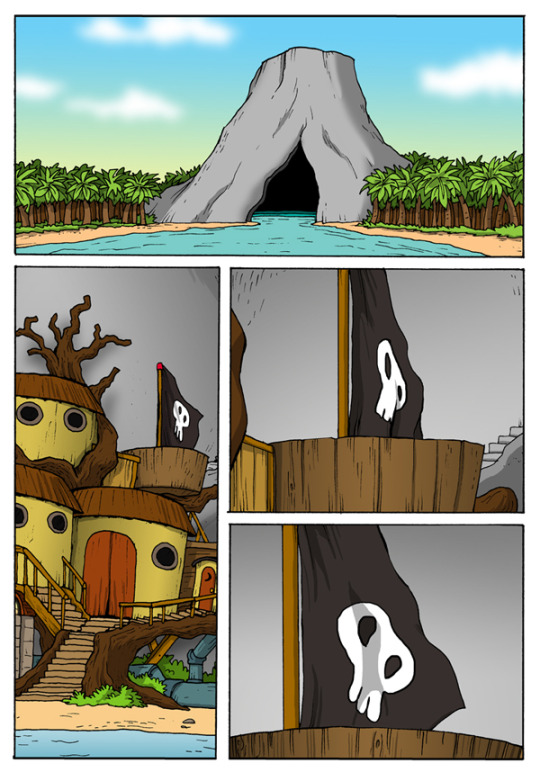

As you can see, the chapter starts off again with the island, but this time now with Sam not part of the picture and its consequences (no one cleaning up the place in the morning). This is not really a bad thing to start the chapter of, primarily because it creates a nice contrast to the beginning of the first part.
Page 3 to 5 however…



Lets just say I get what Dobson tries to show here, but I think is exaggerated to a degree that kinda hurts the narrative; the fact that without Sam, shit does not quite get done.
The problem is the execution of the idea. See, instead of putting the fact Sam is missing into the forefront, the fact stuff has not been done is. Stuff the crew should be able to handle after a very short time of adjustment easily. I will admit, Talus suspecting they were robbed but then asked if he had also looked into the cabinets, is kinda funny. I mean, it fits the character (and sometimes people in real life) to be so adjusted to seeing a certain situation as routine every day, that when it is slighty changed they may initially assume the worst but in reality just one convenient step of the routine was left out. Less forgivable I think is the fact that seeing how Sam did the clothes the day prior, I have to wonder how dirty those guys are that already everything is left in piles of dirt to the point they have only the following alternative as wardrobe.
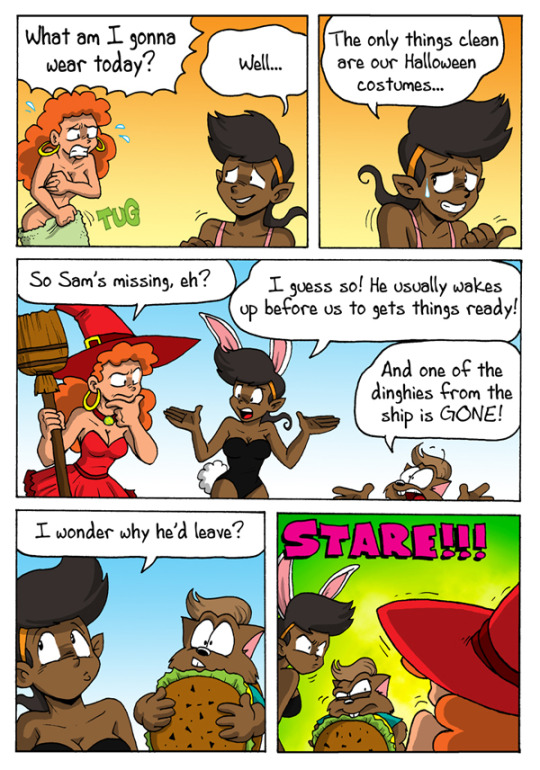
Halloween costumes.
…. Ok, why is there Halloween, and likely a modern day variant of its celebration, in a comic set in a fictional world compared to ours, in a time period it would not exactly exist anyway? Christ on a pogo stick, consistency is all I ask for.
Oh and of course NOW they realize Sam is gone. Because they finally put together that their daily luxuries they took for granted are no longer available.

Hey now, Talus. You all are guilty of being terrible friends. In fact yu are so terrible, you would make Twilight Sparkle vomit at the sight of yours. Also, why of all characters are you wearing a costume? Unlike those two bitches, you still had clean clothes on a few pages ago. Speaking of bitches, Atea in the middle panel looks readyto be edited in a cumshot video. Just saying for all those “creative” editors out there.

YAY! Lets get our slave back so he can do all the stuff we care about but do not want to do.
Seriously, if Dobson tries to convince us they want to get him back because they care for him as a person, he fails miserably. Both by the choice of wording in this page, where Atea and Talus react angrier about the fact that without Sam things don’t work smoothly, rather than concern about his well being, as well as any behavior expressed in the previous chapter. These people are not reacting like friends in worry, they act like spoiled brats. Especially Talus who could still get his stupid burgers if he, as the cook of the crew, would just do his job. All he has to do is additionally open a few cabinets. Also, where in the heck is Uncle Peggy? Oh just go to the next pages so we are getting this over with.


Oh great, the lolcat pirates are back. Because they were so hilarious the first time. And look, they got defeated again. And what is their contribution to the story? To give information on where Sam may have gone.
And it is here now where I have to stop and come back to the pacing issue. Cause the last ten pages here? They are a good example of what I meant with rushed pacing and how it ruins things.
Once more I need to say, I get it. I get the major points Dobson wants to get across. That a) Sam is gone that b) without him things are not all that good for the crew anymore c) they decide they want to find him d) they get information of where he is by going after the one feline that can provide a potential hint. Four major story points Dobson wants to get across. And he is free to get them across. But the way he does it, is just way too fast. Neither the characters, nor the reader really gets time to comprehend that Sam is gone and what that means aside of the surface level loss of luxury Alex and Co are now experiencing. The emotional weight of Sam’s “loss” is pushed aside for the sake of cruising through the plot defined by its surface premise, as fast as possible. And considering that the meat of this story is supposed to be how much Sam means to the others as a person as well as his personal tragedy, intend and execution, thanks to this pacing, does not compute.
Pacing and overall structure are way off and fail to engage us in addition to just killing any suspense in what is going to happen next or surprise us in an interesting fashion. In other words, I am not entertained by this story. It is not funny, it is not sad, it is not “adventurous”.
Personally, I would suggest to actually use the “premise” of those ten pages and turn them at least into two independent chapters of this story overall, to give the premise actually some meat on the bone. The first chapter being a multipager with the crew realizing Sam is gone first BEFORE realizing that without him their luxuries are gone (putting also emphasize this way on the fact they care for Sam also more as a person instead of just the things he does for them) and then once they realize he is missing, deciding to go after him. Only to realize that when they want to prepare themselves for the task (getting their gear together as well as lunch e.g.) that everything is dirty or damaged because Sam normally takes care of it. Leading to a sequence of them having to experience doing Sam’s work for once, making them already there indirectly in part realize what he all does they took for granted.
The second chapter would then be them on the sea, trying to think of where to look at and eventually stumbling upon the cat pirates. Only instead of defeating them easily this time and getting the information, expectations are subverted and the cats actually fight back first, leading to a more hilarious confrontation where Alex and her crew can actually also show how they can be funny and badass, instead of Dobson just always “talking” and trying to convince us they are cool. And look, I do not expect a multi chapter One Piece like battle against the cat captain who turns out to be a master of Scratch Jutzu or something the moment he sniffs catnip. But please, give me something in this story. Some conflict, some diversion, something for characters to actually do that shows they can be badass, funny and awesome. Something that is as cartoony as Dobson likes to claim Alex ze Pirate is, but has never shown in its entirety.
Instead we get to this page, where of all characters Talus is the one who finally seems to realize how he and others took Sam for granted.
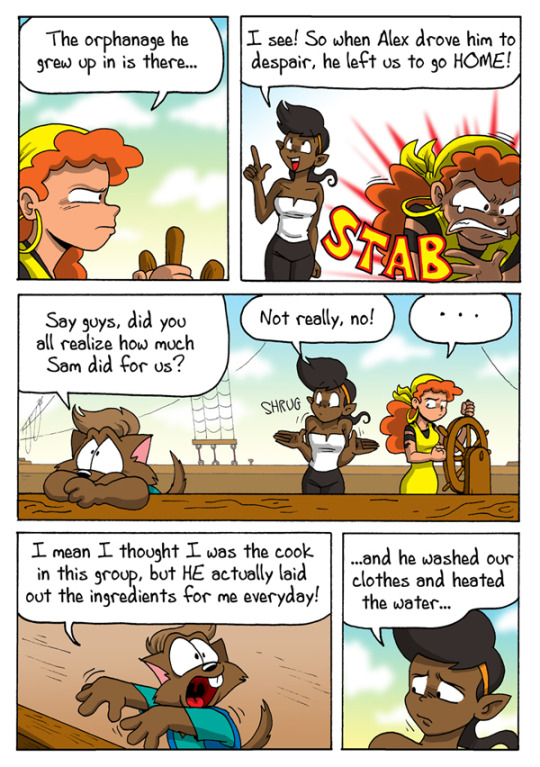
And again, even this page is a good example of terrible pacing. Cause this realization, now shoved in within this and the next page? It would mean so much more if it happened in parts somewhere else in this story before or after, slowly to everyone stepwise. Cause then it would actually feel like a “development” of a chain of thoughts and internal realizations. Instead it is half heartedly thrown in all at once in those pages, to get the point across that NOW Sam’s “friends” finally realize, they took him always for granted.
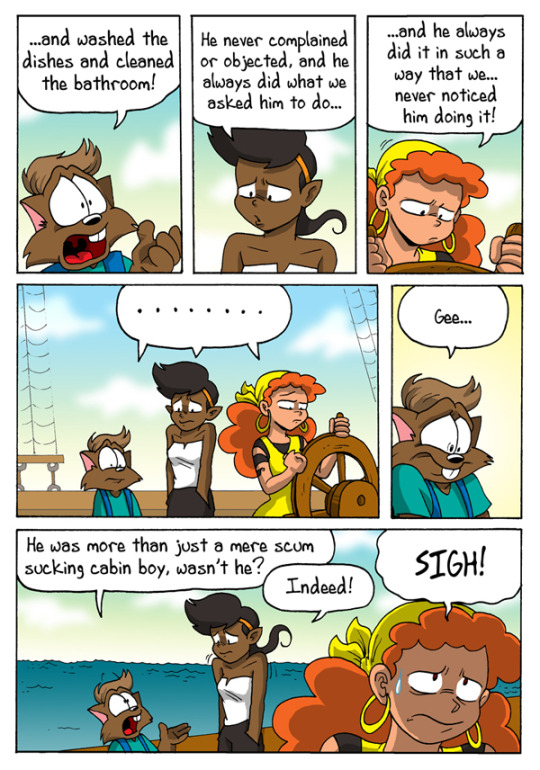
Congratulations on realizing that you are the real scum in this story. What do you expect from me now? To give you hugs and feel pity for you like you are characters in Steven Universe, all because you had an epiphany? You do not deserve mine or any readers sympathy, just because NOW you feel bad for your terrible behavior. Cause if I did, it would just feel rewarding in a certain manner. And you do not deserve a reward. You have to make things up first or at the very least put in some sort of effort to show me, that you are not just feeling bad, but are willing to change for the better. Otherwise you are in the future still just the same toxic abusers you were two pages ago.
... man, that really felt like me already venting at Steven Universe.
Anyway, we have reached the town where Sam is from…

And it looks NOTHING at all like the artwork from Legends implied parts of the town to look like


Where are the badly drawn docks? The houses that imply this is not just a small village on the beach but an actual small town? The twon square where they sell underaged boys as slaves? Jesus Christ, what is the orphanage going to look li-

Nevermind. The orphanage is crushed. And all the people that lived in it are dead.
... WHAT THE HECK IS WRONG WITH YOU, DOBSON! This is genuinely a sick joke here. Look, I am all for black and dark comedy myself, but this feels cruel. I need to remind you, Alex ze Pirate in Dobson’s eyes was also meant to be a comic for all ages. Meaning something also little kids should be able to read and enjoy. Pushing aside how much of that would be bullshit by the shitton of sexist and sex jokes in other strips of the comic alone, this here is not the kind of joke I would like to see a little kid being exposed to when reading any form of story.
Look, I am not saying you can’t make fun about death. But Death is also a major part of life, which many of us are already being exposed to at an early age. And I think it is important that when we talk about death as a subject in a story for kids, we should actually address it in a “mature” manner the kid may understand. That death, as in the genuine loss of a life and not e.g. an awesome interpretation of the Grim Reaper as written by Terry Pratchett, is tragic. That it means permanently losing someone you or someone else loves. That when talking about it, we should talk about it in a serene manner. And there have been great kids stories who tackled the subject directly or indirectly. A Land Before Time for example, the loss of Littlefoots mother and how he “copes” with it while the majority of the plot still focuses on an adventure to find the Great Valley… that is great. But this thing here that Dobson does? To create a shocking revelation and then sell it as a joke based on the fact that Alex, Atea and Talus react with jawdrops to it? It is not handling the death of those children with any form of gravitas in a story that supposedly is meant to be emotional and play with your heartstrings. And yes, we know nothing about those kids, they are essentially non entities to further the plot. But in context of the story, you have to consider, those kids that are “unimportant” to the reader? For the character of Sam, those people were family. At page 14, we as readers start to realize what Sam finding this locket and going back to his hometown only to find out everyone he knew is dead must mean for him. We, people with even an ounce of empathy and understanding how tragedies should be in part written realize, that shit just hit the fan for Sam and that the story should genuinely focus on how Sam would deal with such a tragedy. But does Dobson treat this revelation with any grace or dignity? NOPE!
It is just a bunch of information dropped on us randomly by an old guy who (I guess similar to Dobson) does not even care that kids died. They are just a plotdevice.
Oh and also most of those kids died of an infectious disease where most people die of dehydration after literally shitting non stop. Just to add additional gravity and dignity to the loss of prepubescent lives that should count as Sam’s siblings.
You know, I have to change my opinion on Alex. She is not the worst abuser of Sam. The worst person to ever abuse Sam is Andrew Dobson himself. Cause at least Alex did not kill his extended “family”. And to think this “children comic” was written by the same guy who made a “So you are a Cartoonist” strip where he talked about how kids media can tell more mature comics with more gravitas than live action stuff and novels meant for people that aren’t just children, young adults or mentally stucked manchildren. Dobson, after this page you have no right to call your stuff “appropriate for children” or mature anymore.
I am genuinely furious at this page right now as that I can go on. So here, have the last page of this chapter so I can wrap this up and enjoy some good forms of fiction…
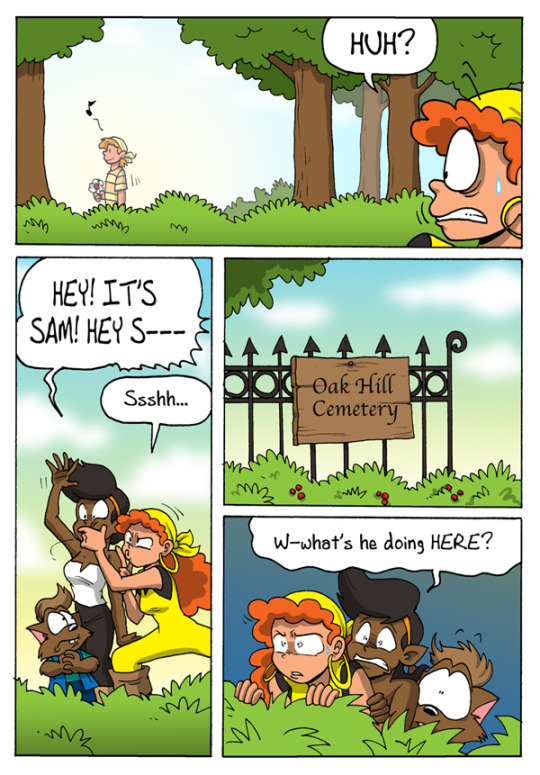
Well Atea, everyone he knew from this village and potentially cared about died in an house collapsing with no one having removed the remains still and he is going on a cemetery. UNLIKE DOBSON WHEN WRITING THIS, USE YOUR BRAIN YOU INSULT TO LESBIANS!
#Andrew Dobson#adobsonartwork#syac#alex ze pirate#sam the cabin boy#fuck you tom preston#tom preston#webcomic#comics#comic review#talus#atea#loss#so you are a cartoonist
47 notes
·
View notes
Note
Hey there's two parts to this. My first question is How do you handle writer’s block? Writing can be an emotionally draining and stressful pursuit. Any tips for aspiring writers? Bonus Question How do you deal with emotional impact of a book (on yourself) as you are writing the story?
Hi Nonny, thanks for asking!
Okay, so... I have thoughts about this, and that might make this answer a bit, uh, longer... than you were expecting. Sorry in advance if you were wanting something quick.
Right, so. Writer’s Block. The boogeyman of writers everywhere. We hear people complain about it all the time, there are tons of guides to beating it (I’m even writing an entire book about getting yourself unstuck when it strikes), and everyone will likely give you a different answer as to why it happens and how to beat it.
To my way of thinking, this is because there are several different types of writer’s block. Too Many Ideas, or Not Enough Ideas, or Mental/Physical Exhaustion, or Written Into a Corner, or Bogged Down By Details, or Missed A Step
1. Too Many Ideas
While this might not sound like it’s all that bad of a thing (how can a creative type have too many ideas?), it can actually be really frustrating to deal with. Sometimes it means you keep getting ideas for new projects, and sometimes it means you keep getting new ideas to squeeze into your current project, and then sometimes it means you keep thinking up different ways to tell the current story.
Ugh. Well. Silver lining, your creative juices are certainly flowing. But that doesn’t help you get any writing done.
So if you’ve got this type of writer’s block, the best way I’ve found to deal with it is to have a notebook or word doc (or something along those lines) to jot down all the ideas as the come to you. You can even have a separate document for the ideas that pertain specifically to your current project. But the trick here is that as soon as you write the idea down, you push it aside and ignore it.
This can be hard to do at first. New ideas are soooo shiny that you can’t help but want to play with them. So it can help if you set aside a bit of time every week to go over all the ideas you’ve jotted down. Just make sure it’s a time that’s distinct from your writing time. Once you’ve gotten into the habit of this, then the flurry of ideas will no longer hinder your writing.
Alternatively, you can try channeling all that extra creativity into another art form. Especially something big and messy ;)
2. Not Enough Ideas
When people talk about experiencing writer’s block, they’re usually thinking it’s because you don’t know what to do next in your story (i.e., that you don’t have enough ideas), but this is actually pretty rare. Usually you’ve hit that block because of one of the other items on this list.
But, when it is because the well has run dry (so to speak), then it’s like trying to start a car with a dead battery. And just like that, you need to grab some jumper cables and give it a boost.
Do some yoga, go for a walk, listen to music, watch the clouds drift by, go stargazing, get your heart pumping, read poems that make you cry.
Basically, you need to shake things up. Drag yourself out of the rut you’ve found yourself in by doing things non-writing related. Not only is that good for your general health, it’ll recharge your creativity.
3. Mental/Physical Exhaustion
This type of writer’s block has probably become the most common over the last year or so. It is dang hard to be creative when you are mentally and/or physically drained. This can come about because of stress, lack of sleep (literal exhaustion), pain, injury, illness, or lack of self-care.
The most important thing with this type of writer’s block is to remember that it’s okay to take a break. Your mental and physical health is more important than completing a writing goal.
Give yourself the space to rest, and your creativity will return.
4. Written Into a Corner
Let me tell you, I’ve fallen into this one a lot. It sucks, and it can take awhile to figure out why it’s such a struggle to write. It usually happens when you are determined to have a specific event or sequence of events play out in your story, but your subconscious is recognizing that the scene/event/storyline doesn’t fit.
If you can’t seem to figure out how to connect your current scene to where you need to go next, then it’s very possible that you should remove the current scene entirely, or completely rewrite/change it.
You might think this only applies to pantsers (people who write without having an outline first), but it happens to plotters just as frequently. It’s not about a lack of planning, it’s about not realizing that the way you’re forcing the story doesn’t match with some other part of it. Maybe because of extra world building, or research, or character development, or lines of dialogue three chapters back, but whatever the reason, it’s made the current scene not-quite-fit.
This is okay. It’s not a failure of planning or creativity or you as a writer. It just happens sometimes.
Go back a scene or two and rethink how to get to the next plot point. Can you rework the troublesome scene? Do you need to remove it? Replace it with something else entirely? Whatever the solution, it’s okay. Your story will be better for it.
5. Bogged Down By Details
Along the same line as the previous one, this kind of writer’s block often leaves you unsure of how to progress to the next scene. The difference here is that this time it’s because you let the narrative point of the scene become lost in the minutiae. Maybe it’s a big info-dump, or maybe you let the characters get sidetracked by sightseeing, or maybe some random supporting character has been elevated to having a three-page monologue.
Whatever the cause, you’ve tried to cram too much information into the scene and now it feels weird to connect it to the next one.
Read over the scene and identify what information absolutely needs to be there for the story to progress. Is there any information that doesn’t need to be there, but is good set-up for something later? Keep those bits. Everything else you need to cut.
Yup. Sorry.
If you really like the information or dialogue or what-have-you, save it and see if you can work it in to other parts of the story in small bits. A little extra world building here and there can really make a story feel alive. It’s when there is too much in one spot that it becomes a problem.
6. Missed A Step
This one is almost the opposite of the last two points. Instead of having too much, or conflicting information, you’re missing something. For me, this is usually a rewrite/edit writer’s block phenomenon, but I’m sure there are lots of writers who experience it during their first draft too.
Basically, in your hurry to get from point A to C, you forgot all about B. Whoops!
If you’re writing (or editing) and the scene feels disconnected or like you’re having to do a lot of flashback-style inserts to get the reader up to speed, then you probably need to add something to a previous scene, or add a new scene altogether.
Usually this one (at least for me) doesn’t feel as much of a ‘block’ as the other types, but more like I can’t move forward until something is resolved. That something being the missing info/scene.
So yup... there are different types of Writer’s Block, and how you deal with it depends on what type it is. You might find that you experience one type more than the others, or that you experience a different type that I didn’t describe (in which case, please share). However you are facing off against writer’s block, just remember that it isn’t the end of the world. It’s just a sign that something needs to change.
As far as tips for aspiring writers go, I’ve answered a couple of different asks about that sort of thing before, so (to keep this from being monstrously long) check those out.
For your bonus question... I just let myself cry when I need to, or bounce around after the scene is written, and/or do some light sparring with my partner to work out the anger/stress afterwards.
Emotionally charged scenes are rough, but so rewarding. Keep on writing ‘em :)
Thanks again for asking!
xoxo
3 notes
·
View notes